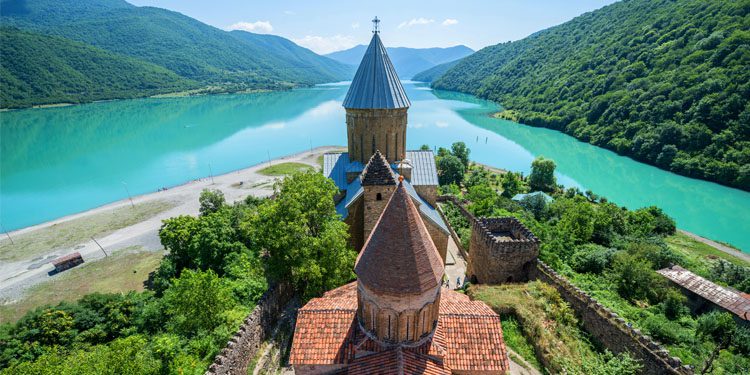Georgia is a country located in the western part of Transcaucasia on the eastern coast of the Black Sea. In the recent past, the country, together with Russia, was part of a single state of the USSR. Therefore, there are no problems in communicating in Russian with the local population.
Ancient cities, monasteries and temples are located among the stunning beauty of mountain landscapes. The hospitable Black Sea coast welcomes hundreds of thousands of tourists every year. A car will help you cover most of the important sights of the Caucasian country. We will tell you in detail what to see in Georgia by car on your own.
Advantages of renting a car
You can fly to the capital of Georgia – Tbilisi and rent a car that you like. They do this, for example, through an aggregator localrent.com. You can find out all the conditions for car rental on this website. You can book a car online directly from your home. Upon arrival or arrival in Tbilisi, one of the best rental companies in Georgia — Localrent will hand over your car at the exit from the airport or train station. Having taken a car, feel free to start a road trip around the country.
Tbilisi
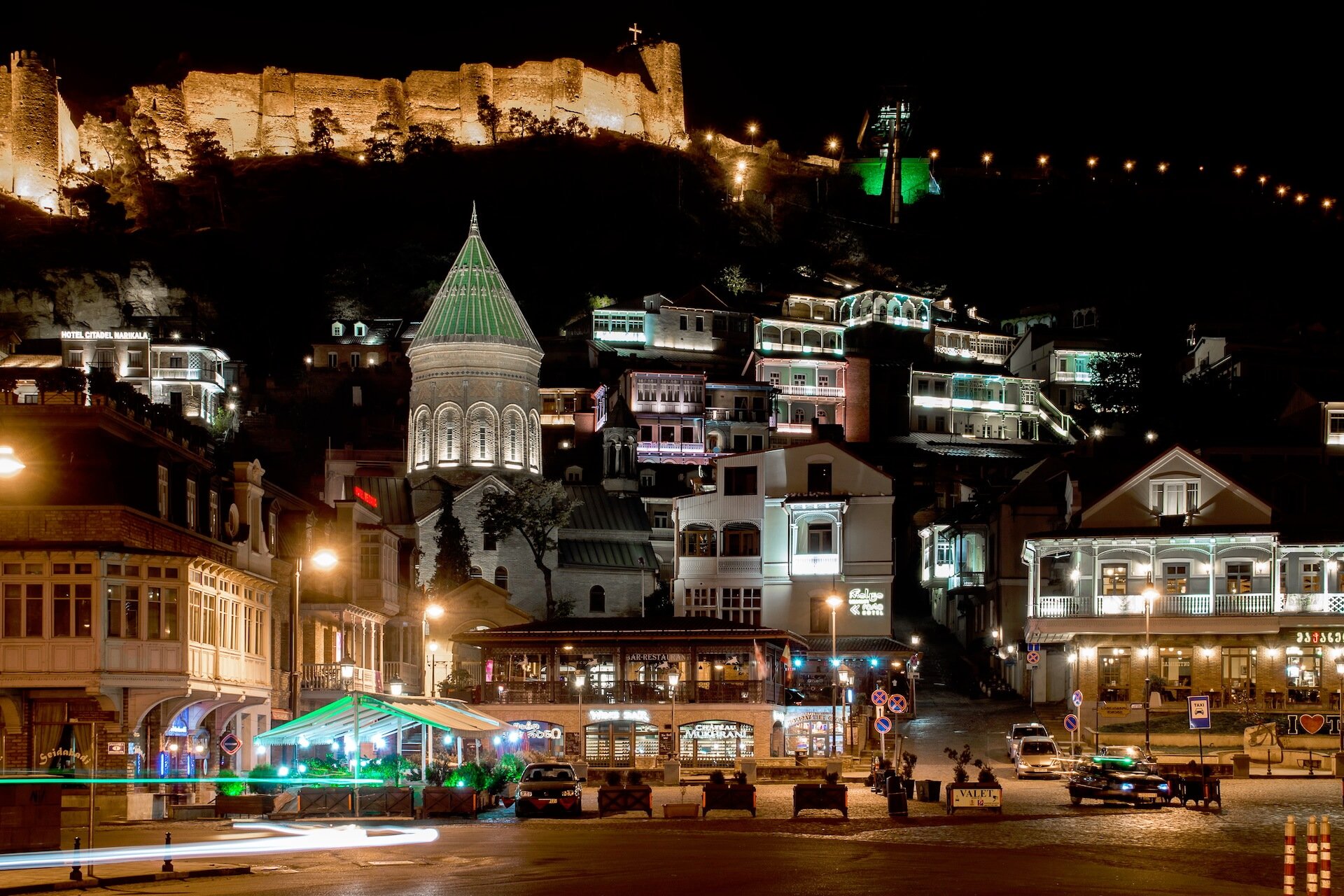
The former Soviet republic, now the independent state of Georgia, stretches from east to west for 500 km, and from north to south for 280 km. Therefore, when traveling around the country by car, it is advisable to choose two or three base points, from where you can go for sightseeing and where to return for an overnight stay.
We recommend choosing the capital city of Tbilisi as the first such point. Arriving in the city, the first thing you need to do is check into the hotel. There are no problems with choosing hotel rooms here. If you arrive in your own car or have already rented a car, then take care of the parking lot close to the hotel.
The capital is so full of all sorts of attractions, and if you still want to travel around the country, then we advise you to leave your transport alone for now and take part in several city sightseeing tours. But if there is an empty seat in the car, you can invite a guide from the local travel agency and take an informative walk through the city streets together.
As a rule, a sightseeing tour includes a tour of the following objects::
- Metekhi Temple
- Rike Park
- cable car ascent
- Narikala Fortress
- Anchishati Temple
- Rustaveli Avenue
- ethnographic museum
- Sioni Cathedral
- Freedom square
- main cathedral of the Holy Trinity
- district of sulfur baths
- the pantheon on Mtatsminda
- church of the holy Father david
- Turtle Lake
What to see in Tbilisi in 2 days — 20 most interesting places
Among all the sights of Tbilisi, we recommend paying special attention to visiting the pantheon on the slope of Mtatsminde Mountain – the place of graves of writers and public figures of Georgia. The first significant burial (1829) was that of the famous Russian diplomat and great playwright Alexander Griboyedov, author of the famous play “Woe from Wit”, who died at the hands of religious fanatics in Persia. Later, his wife, Princess Nino Chavchavadze (1847), was buried nearby.
The tour will take no more than 1.5-2 hours. When it’s over, ask your guide for the best place to eat and you’ll get advice you won’t regret. After spending a day or two in Tbilisi, take one of the routes recommended by local car rental company Localrent. The first trip will take place along the most picturesque and legendary Georgian Military Road.
Zhinvali Hydroelectric Power Station
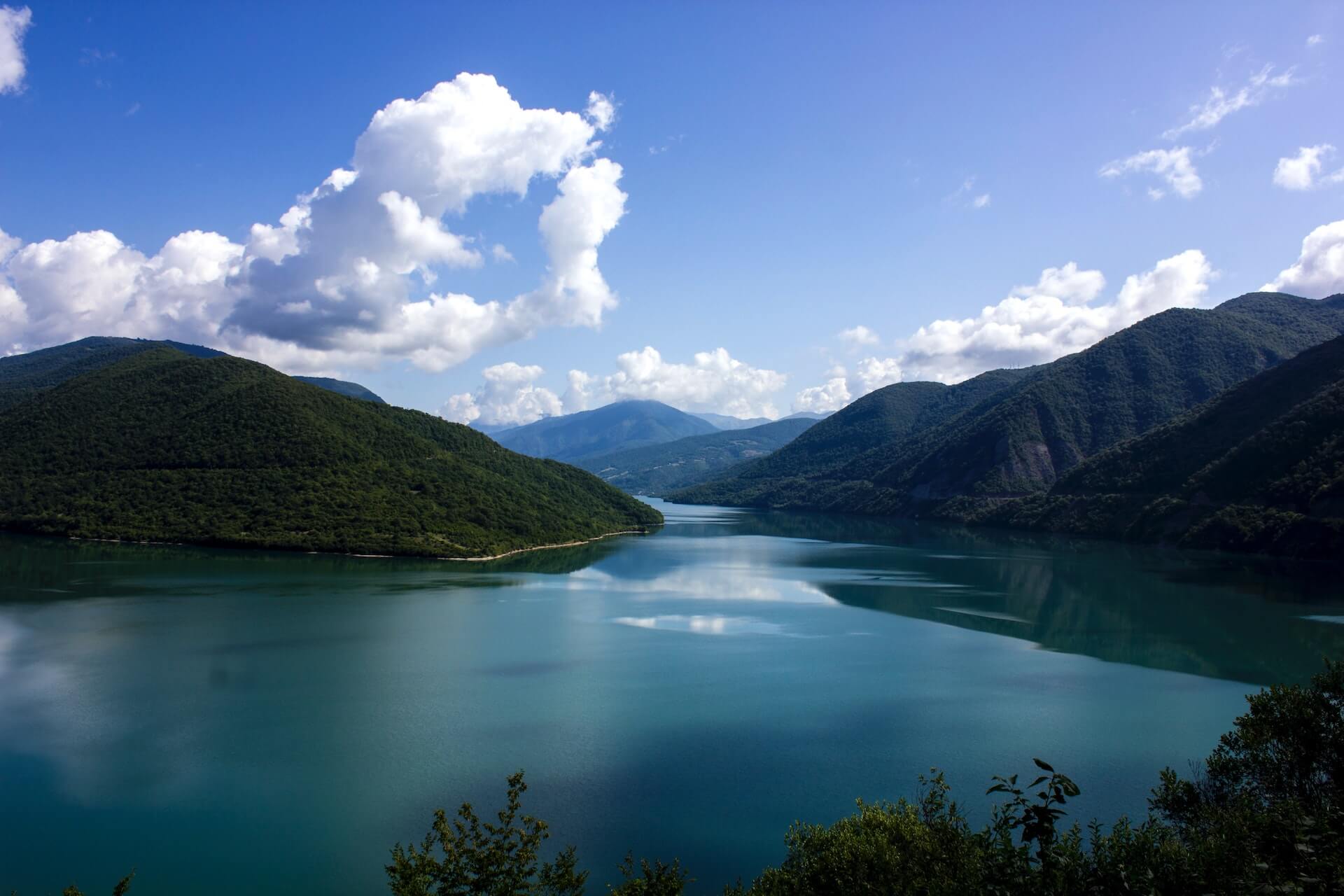
The first attraction that you will encounter on your way will be the Zhinvali reservoir. The artificial lake is a hydroelectric power station of the Zhinvali hydroelectric power station. As a result of the flooding of the valley in 1971, 18 villages were submerged, and their inhabitants were relocated to the nearest villages. Also at the bottom of the lake are the remains of the ancient city of Zhinvali, along with castles, towers, arched bridges and basilicas.
The reservoir is one of the most picturesque places. The artificial reservoir attracts many tourists from different countries with its beauty. It is better to go down to the water on foot. Local residents do this in their own cars, but the risky descent is available only to them.
Anauri Fortress
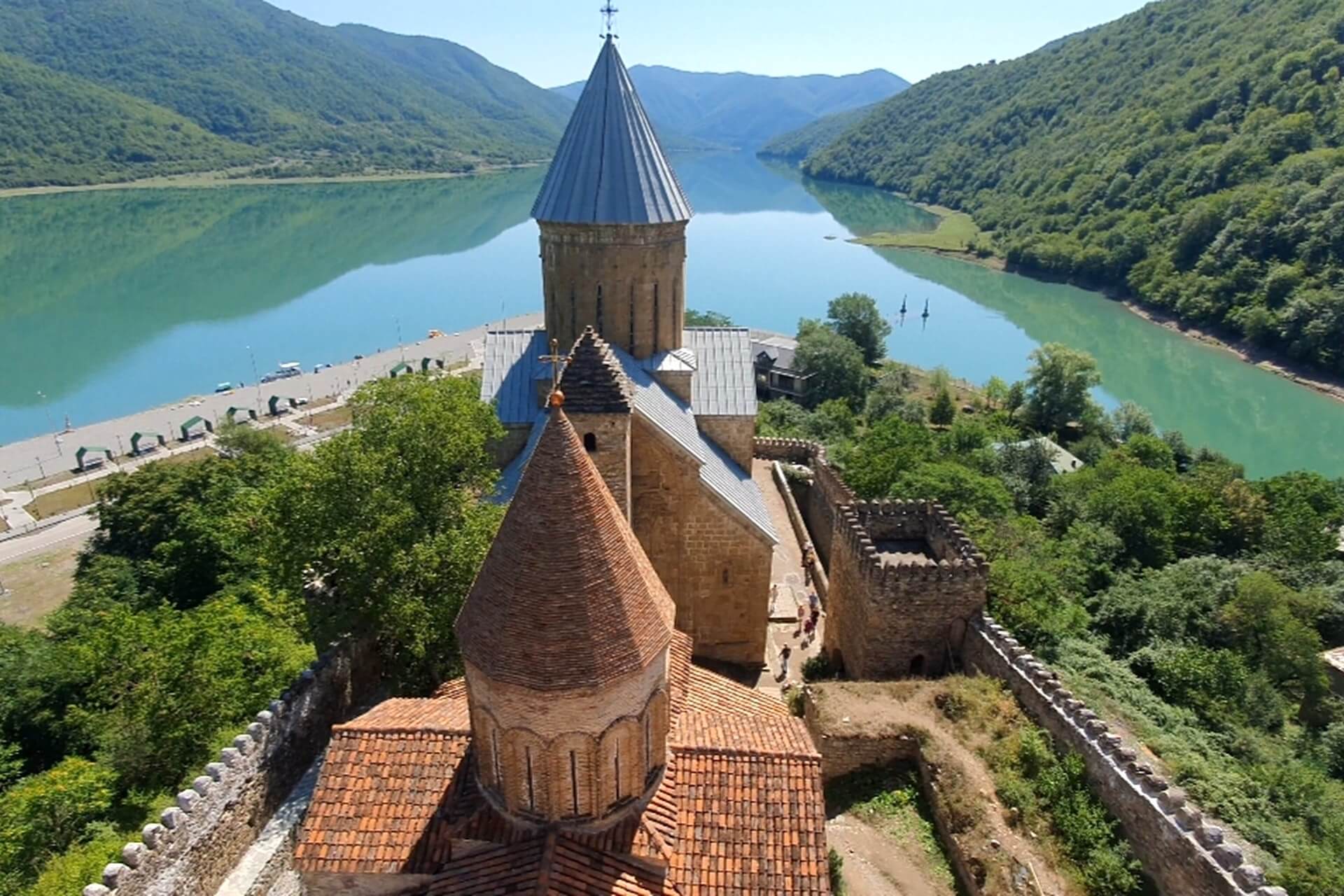
It is better to admire the beauty of the Zhinvali reservoir from the side of the Anauri fortress, which, as it were, hangs over the man-made lake. The ancient citadel, built in the 16th century at the confluence of Aragvi with a small river Vedzathevi, was the main defensive structure of the Aragvi eristavs – the then rulers of this region.
Anauri Fortress is one of the main attractions of Georgia, which in 2012 was included in the application for inclusion in the UNESCO World Heritage List. The citadel is considered one of the best-preserved monuments of the early feudal era.
Until the beginning of the XIX century, the fortress played an important role in protecting the population of Transcaucasia from unfriendly neighbors. After Georgia became part of the Russian Empire, a Russian garrison was stationed in the fortress, which guarded the approaches to the Georgian Military Road.
In 1829, during his trip to the Caucasus, the fortress was visited by the great Russian poet Alexander Pushkin. With the departure of the Russian troops, the fortifications fell into disrepair and desolation. Ananuri Fortress is open to all comers. Entrance to its territory is free.
In the fortress you can see three temples and several towers. The Assumption Church was built in 1689. Its walls have partially preserved decorations in the form of crosses and vines. The Church of the Virgin Mary and Spasskaya Church are located nearby.
Gergeti Trinity Church
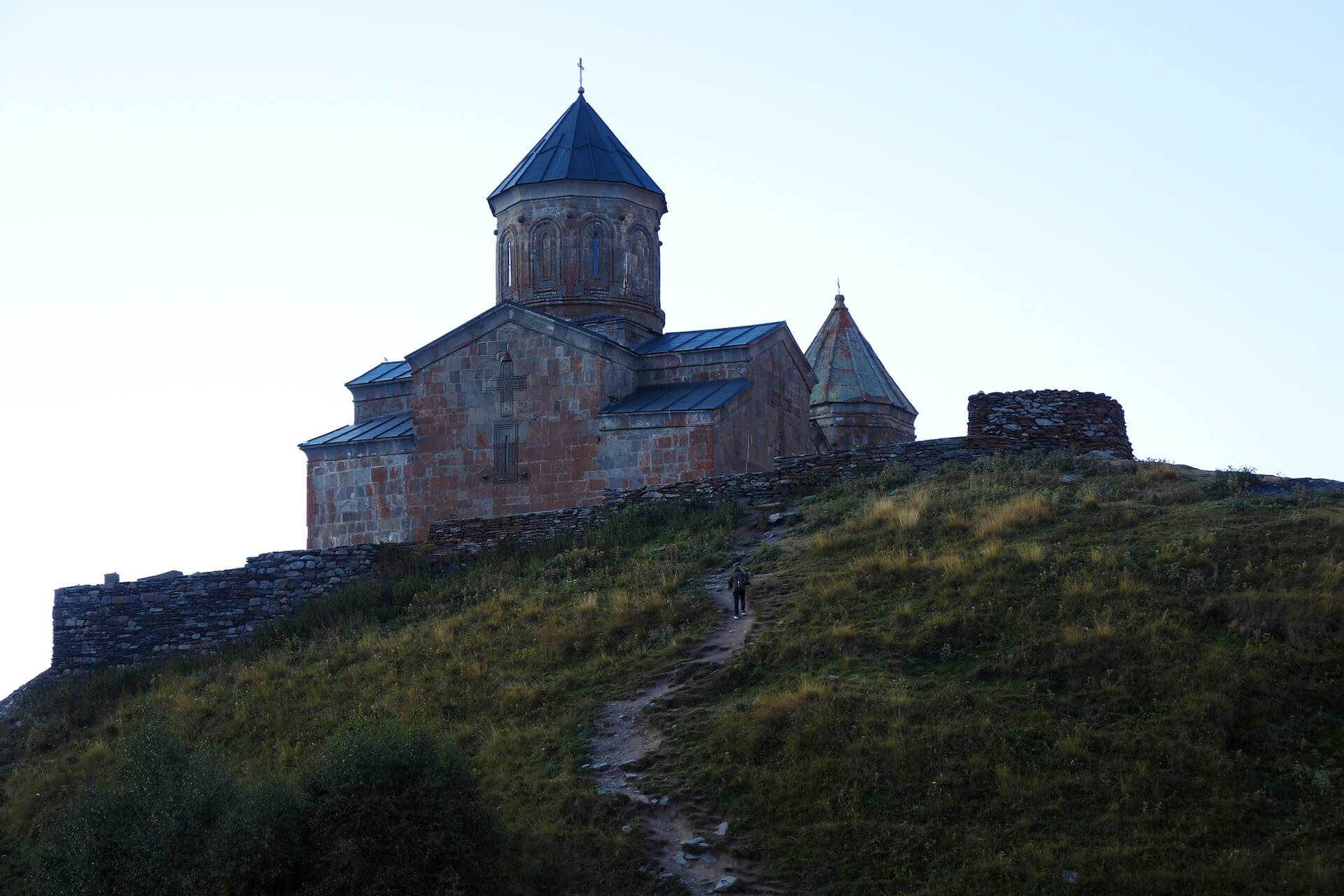
After passing the Anauri fortress, you will get to the village of Gergeti, which is famous for the Holy Trinity Church. The temple is considered one of the most picturesque religious buildings in Georgia. It is located at an altitude of 2,170 meters above sea level. In clear weather, you can see the top of Kazbek from here.
Gergeti Trinity Church, built in the XIV century, became famous for hiding priceless church relics in it during difficult days during the invasion of enemies. The cross of Saint Nina, who preached Christianity in Georgia, was kept here for a long time. Since 1802, the cross has been kept in the Zion Cathedral in Tbilisi.
With the advent of Soviet power, the church was closed for several decades, and only by the end of the century were services resumed in the church. On its territory is the Lavra-a monastery for men.
When visiting the temple, you must comply with the religious dress code. Men can’t come in here in shorts, and women need to give up bright and open clothes. At the entrance to the church, girls and women can be offered shawls and skirts to change into for visiting the temple. Here, on July 16, the Christian holiday of Gergetoba, or the Day of Spiritual Love, is widely celebrated. Then you can direct your car to the Kazbegi National Reserve.
Kazbek
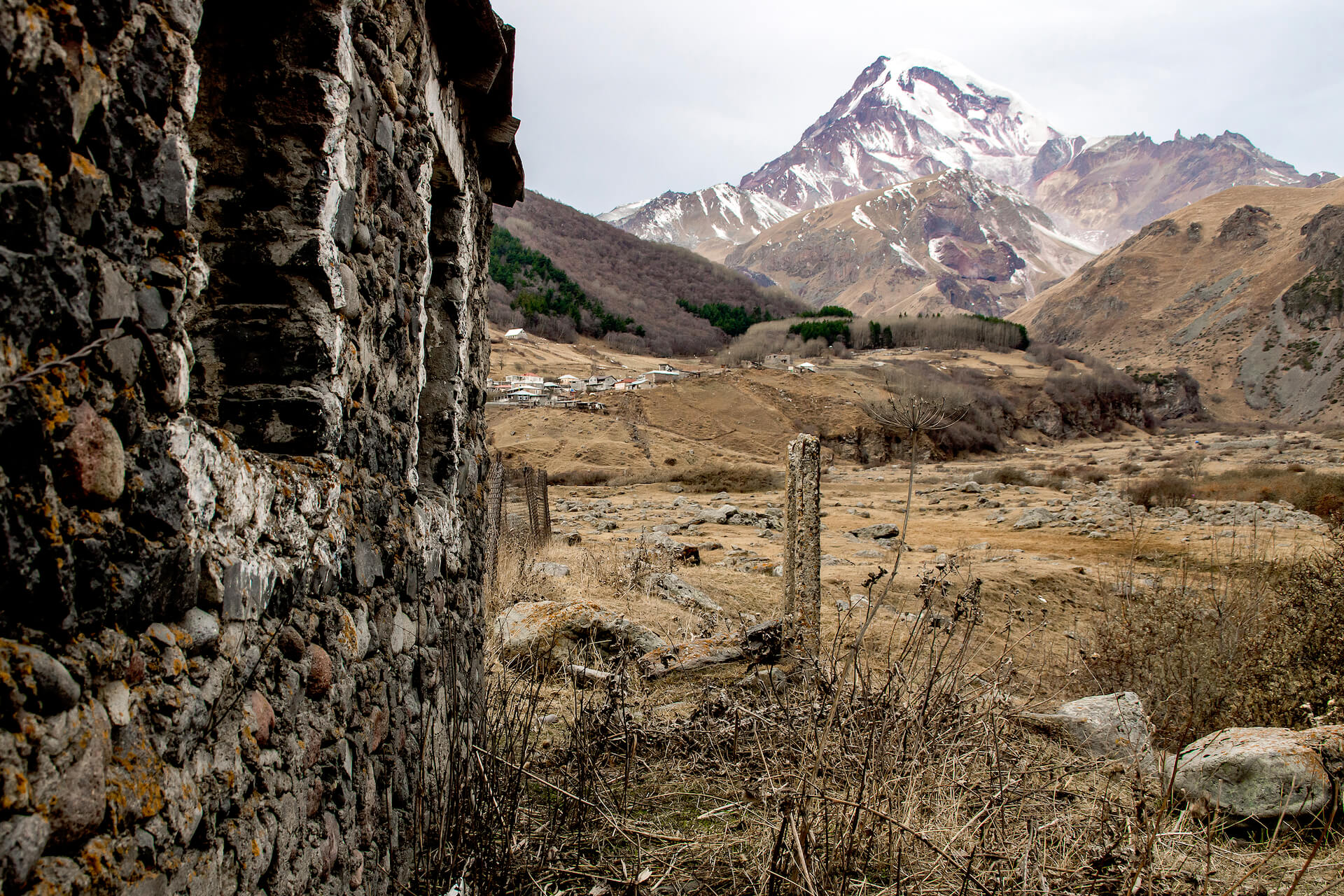
Mount Kazbek or Kazbegi is the third highest peak in Georgia after the Janga and Shkhara mountains. It runs along the border between Russia (North Ossetia) and Georgia. To the east of the peak is the town of Stepantsminda. The origin of the mountain’s name is still disputed by scientists.
Some believe that the mountain was given its name by a noble Circassian who lived on it, while others prefer the version of the noble title Kazgeb, which was assigned to the nobility by the Georgian king Rostome in the XVII century. In fact, the original name of the peak sounds in Georgian as Mzhinvartsveri, which means Glacier Peak.
Mount Kazbek is part of the Kazbegi National Reserve. The height of its peak is 5 thousand meters above sea level. The road from Tbilisi runs along the Georgian Military Road through the Gudauri Pass. The best way to enjoy Kazbek is to come to the city of Stepantsminda.
From here, the five-thousand-meter peak opens up to tourists in all its glory. You can also stay in the village of Gergeti, where there is a decent hotel that offers a stunning panorama of the legendary mountain. Here you can take part in the conquest of mountain heights. Kazbek Mountain is climbed by an organized group led by an instructor.
The route to the mountain starts from the town of Stepantsminda and ends at the base camp at the weather station at an altitude of 3,650 m above sea level. Tourists go up the trail light, and backpacks are delivered on horseback. The entire trip will take 2-3 hours. Further ascent to the very top of Kazbek is made by equipped climbers for several days.
Stepantsminda
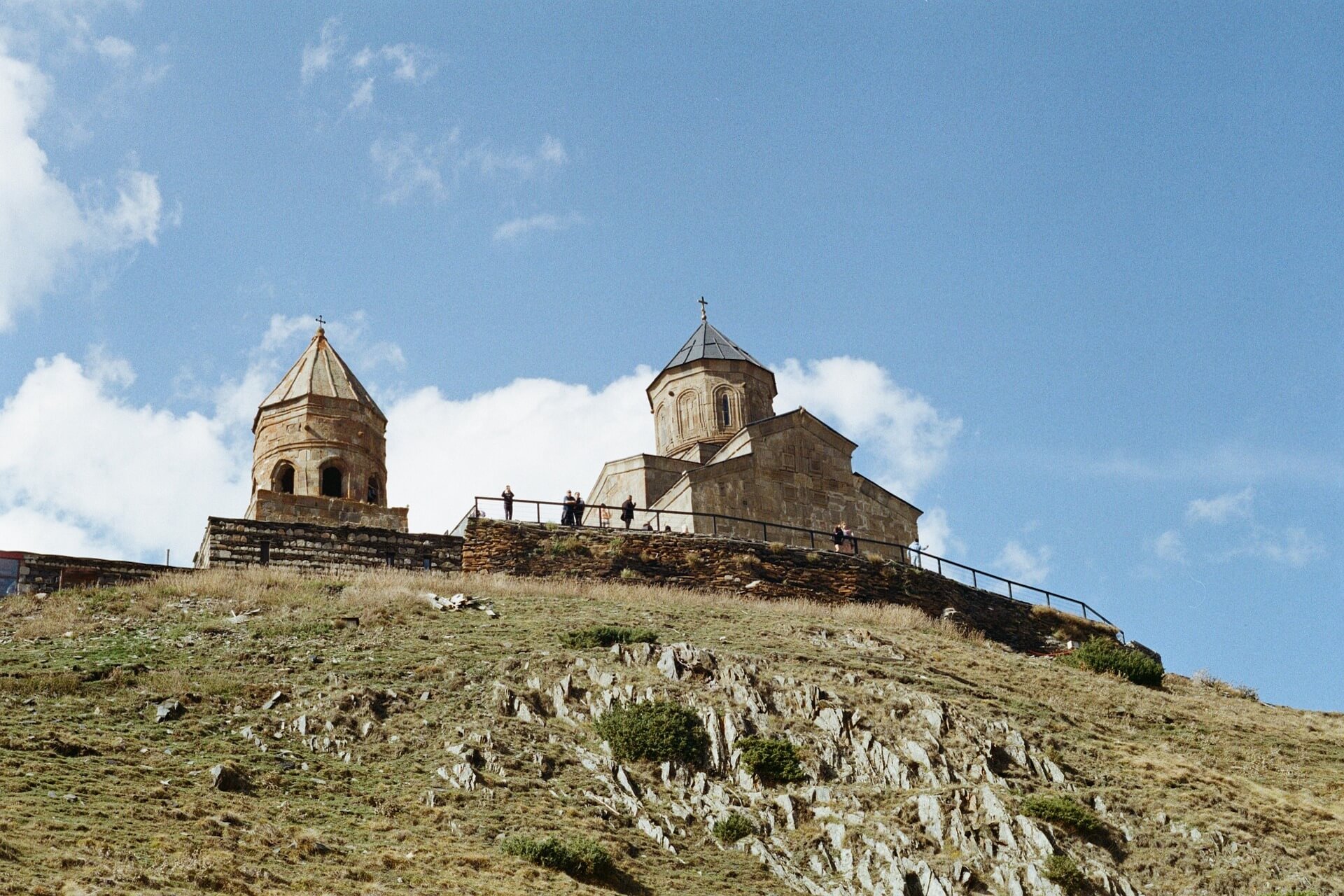
Staying in the urban-type village of Stepantsminda, in addition to Kazbek, you can spend the rest of your time exploring local attractions such as the Cross Pass, where the Peoples ‘ Friendship Arch is located, the Daryalov Gorge and the Keli Plateau with volcanic lakes. A walk through the Kazbegi National Nature Reserve will bring you an unforgettable experience of the natural beauty of mountain landscapes at an altitude of 1,400 meters above sea level.
Racha-Lechkhumi and Lower Svaneti
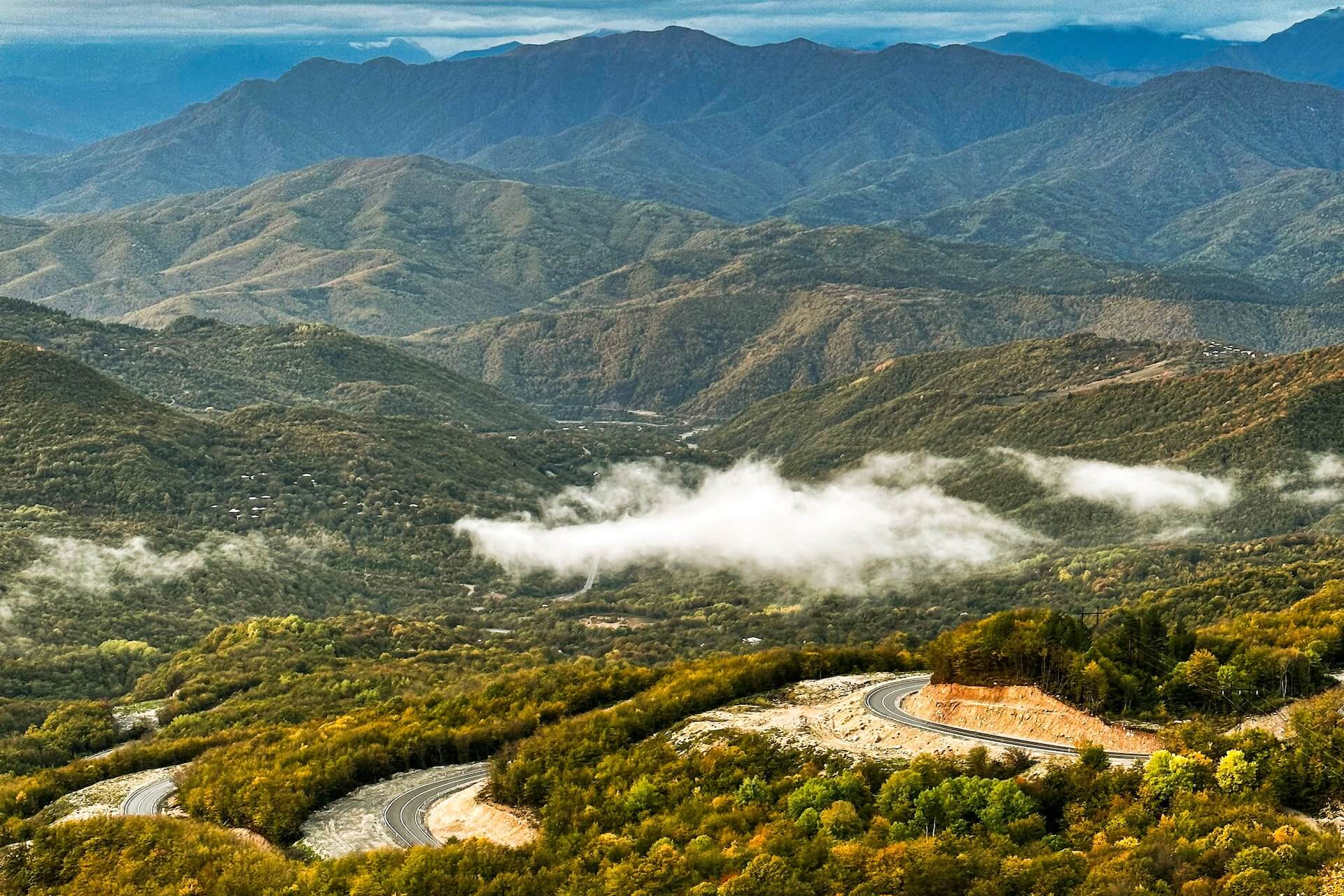
After seeing all the important places along the Georgian Military Road, you can head straight to the north-west of Georgia to the regions called Racha-Lechkhumi and Lower Svaneti. Once it was different areas. By the beginning of the 19th century, the former was part of the Imereti Kingdom, while the latter remained part of the Principality of Megrelia.
Together they became part of the Russian Empire, and since 1846 they have formed a single administrative region. Part of the territory was lost due to the recognition of the independence of South Ossetia.
Today Racha-Lechkhumi and Lower Svaneti (Kvemo-Svaneti) is a unique high-mountain wine region of Georgia. Alpine meadows, vineyards, mountain air-all this is called Georgian Switzerland. The administrative center of the region is the town of Ambrolauri.
The road from Tbilisi is so picturesque that you will want to constantly make stops to take photos and admire the stunning mountain scenery. Using the services of Localrent, you can rent an SUV for this trip.
To get to the main city of Ambrolauri region from Kutaisi, you will have to travel 115 km on an asphalt road, and from Tbilisi you will have to drive 270 km. In the city, you can visit the Royal Khvanchkara Winery. It produces four types of fine wines: Khvanchkara, Usokhelauri, Tvishi and Alexandrouli. In summer, there are guided tours with tastings.
Further traveling around the region, you can visit the ancient church in Nikortsminda of the 11th century, the Barakoni temple, visit the cities of Shovi, Oni, the village of Shkmeri and the capital of Lechkhumi-Tsageri.
Upper Svaneti

Svaneti consists of two regions – Lower and Upper Svaneti. Both parts are separated by the Greater Caucasus Range from the north and the Svan Ridge from the south. For several millennia, Svaneti has not known seizures, there were no wars and serfdom did not operate, and the nobility was conditional in nature. In the 19th century, individual communities of Svaneti recognized the power of the Russian Empire, which ended with the revolution of 1917.
Since its independence in November 1990, Svaneti has been part of the Georgian Democratic Republic. Since you have already visited Lower Svaneti, it remains to visit its upper part. The local population calls Upper Svaneti Zemo-Svaneti. The region is fenced off from the rest of the world by mountains.
If you get here, you will never regret it. Here you will find stunning mountain landscapes. By the way, the highest peak of Georgia, Mount Shkhara, is located here – its peak height is 5,068 meters above sea level, which makes Shkhara the third highest in the Caucasus after Dythau and Elbrus.
There is still no road connection between many villages – local air lines help out (remember the famous comedy “Mimino”). The only way to visit Upper Svaneti by car is to come to its capital Mestia.
Mestia
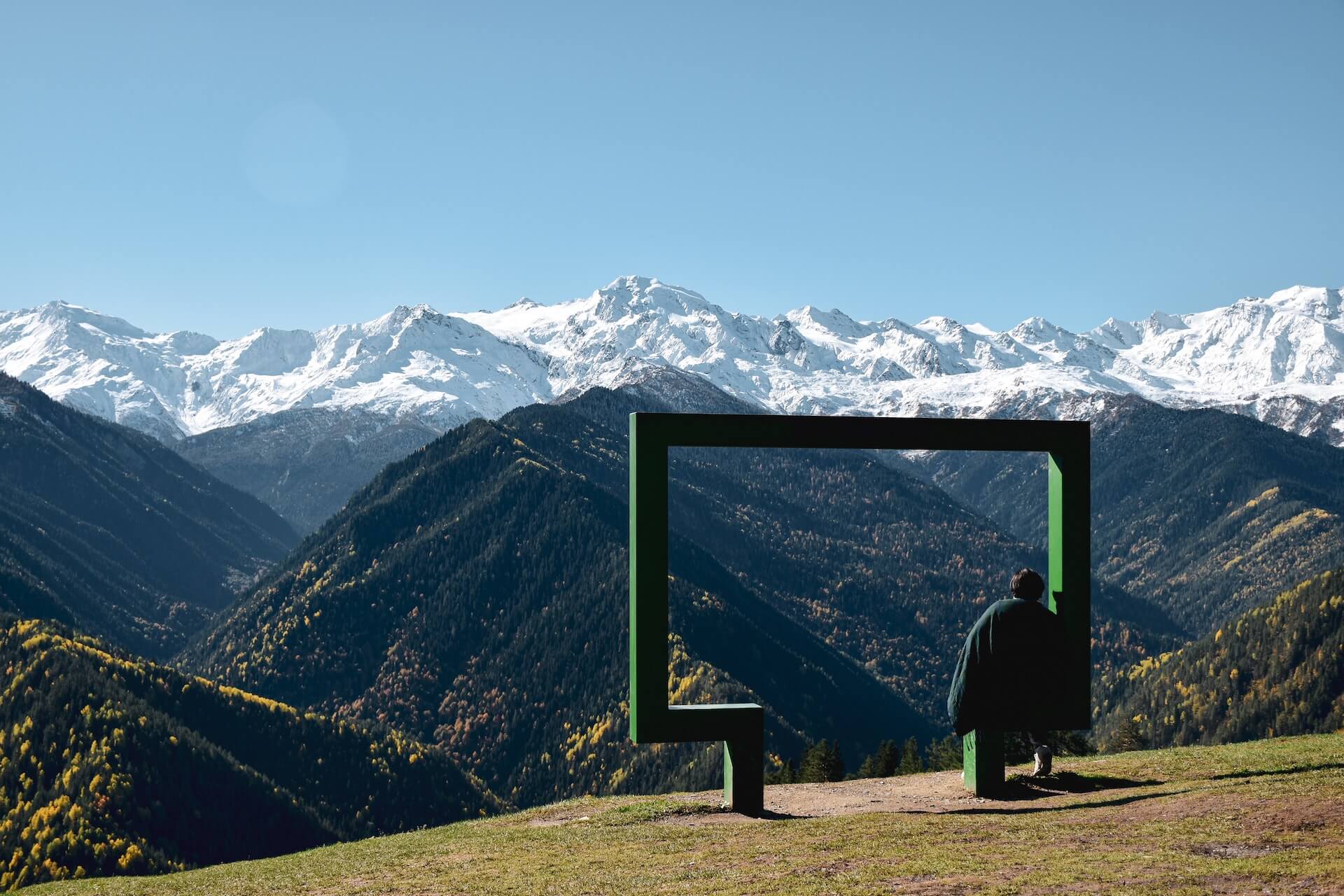
To get to Mestia from Kutaisi by car, you need to overcome 240 km of travel. It is better to do this on an SUV. You will have to go on a difficult mountain road. If you do not have experience driving on risky serpentines, then it is better not to start this business yourself. You can come to the city and return by taxi – it will not be cheap. You can also leave your car in Kutaisi and fly here by plane.
In the city, the tourist center is Tsaritsa Tamara Street and Seti Square. There you will find shops, hotels, a market and an information center. The rest of the city is a private sector with vegetable gardens and pastures.
A cable car takes you to the middle of the Zuruldi ridge, where you can dine in the open area or in the cafe of the same name. Here, at an altitude of 2,340 meters, you can enjoy a fantastic panorama of the Ushba peak and the entire Caucasus Range.
Kutaisi

Since you have already visited Lower Svaneti, then you will not miss the second largest and most populous city in Georgia (about 150 thousand people) – Kutaisi. The main city of Western Georgia, the capital of Imereti province, is today a major cultural, business and tourist center of the country, located on both banks of the Rioni River.
The main attraction is the local temple — Bagrat Cathedral. The ancient structure has not survived intact to this day. At one time, the church was severely destroyed by the Seljuk Turks. On the walls you can see partially preserved ancient mosaics, murals, frescoes and magnificent stained glass windows decorating the window openings.
After recent restoration and reconstruction works, the building has acquired a modern look. Try to visit there. From there, the mountain offers a magnificent panorama of Kutaisi.
On the central square of David Agmashenebeli there is another popular attraction-the Colchis Fountain. This multi-level structure is decorated with 30 figurines-enlarged copies in human growth of Bronze Age figurines belonging to the ancient Colchian culture and found during archaeological excavations. Near the fountain there is a museum of Georgian sports, a drama theater, a library, and many other interesting buildings.
Starting from Tbilisi to Kutaisi via Mtskheta, you will meet the cave town of Uplistsikhe, the glorious city of Borjomi, and finally the world-famous city of Gori-the birthplace of I. V. Stalin.
Mtskheta
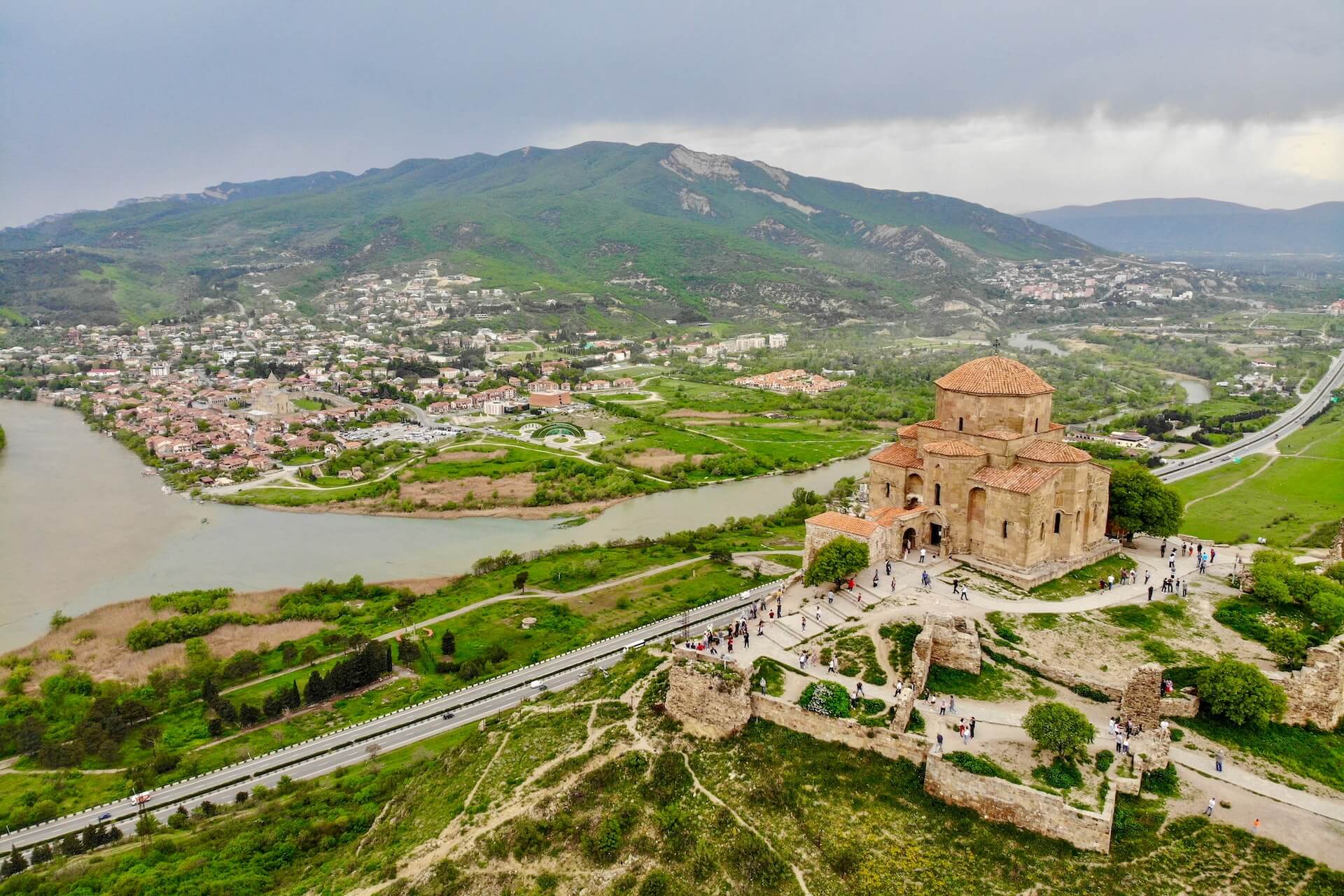
20 km north of Tbilisi, at the confluence of the Aragvi and Kura Rivers, is the small town of Mtskheta. It is the ancient capital of Iberia. Here, in the IV century, Christianity was declared the official religion of Georgia. For many centuries, Mtskheta remained the administrative and religious capital of the country.
After the transfer of the status of the capital of Tbilisi and the total destruction of the Persians in the 8th century, the city plunged into decline and oblivion for a long time. During the Middle Ages, Mtskheta finally established itself as the center of Orthodoxy in Georgia. At that time, magnificent religious buildings were built, which have come down to our time in complete safety.
All of them and other historical monuments of the city were included in the list of UNESCO World Heritage Sites. After leaving Mtskheta, pay attention to the following attractions along the way.
Uplistsikhe
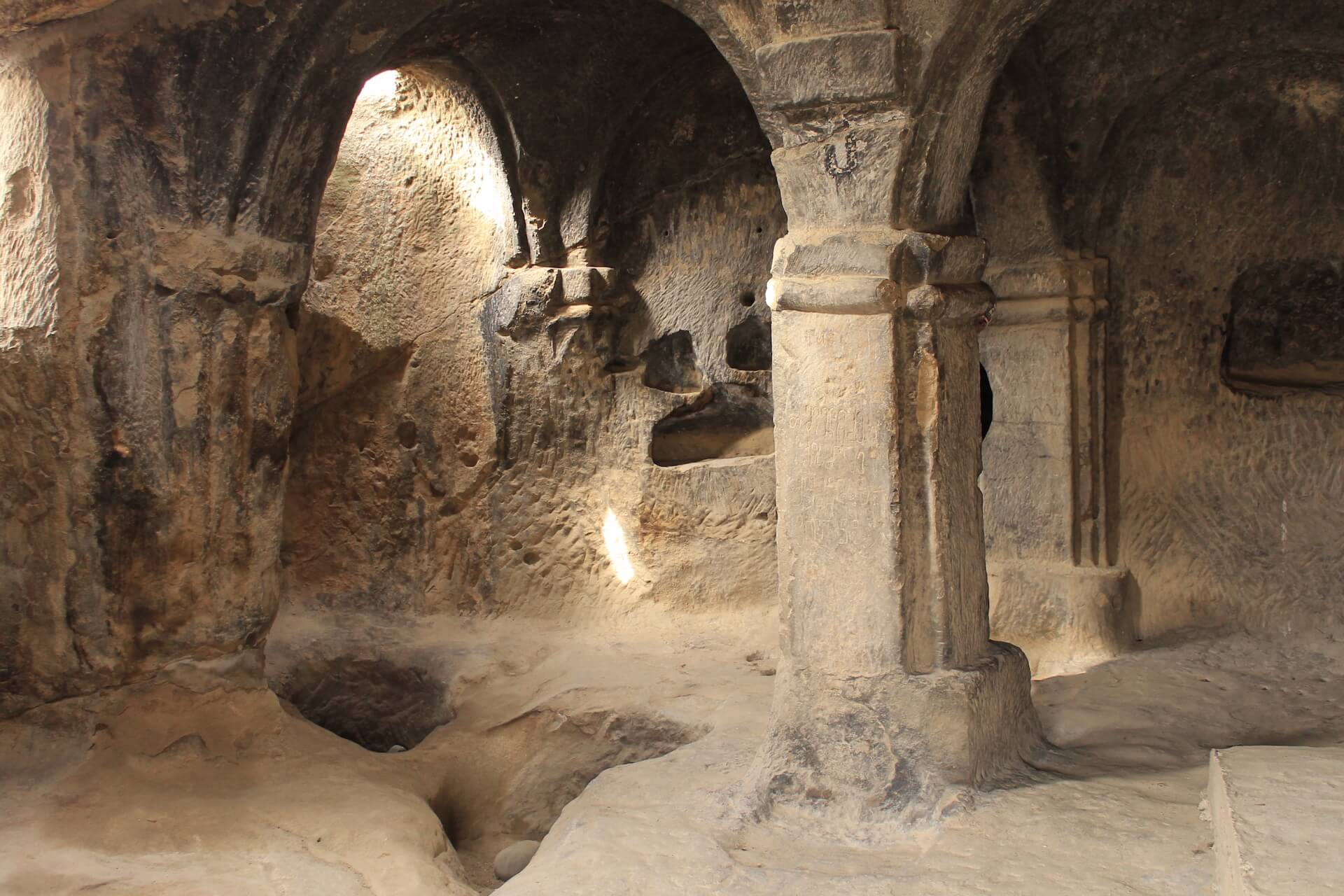
The ancient cave town of Uplistsikhe, carved into the rock, is located on the left bank of the Kura River. The mountain village that emerged in the rock at the end of the II-beginning of the I millennium BC, experienced both ups and downs, and finally was finally abandoned by the inhabitants in the XIX century.
Today, the multi-layered archaeological site is one of the fundamental monuments of Georgian culture. Its uniqueness lies in the partially preserved architectural and religious buildings that were built over several millennia. Uplistsikhe at one time had more than 700 caves and cave structures such as ancient trade shops, 150 of which have been preserved to this day.
At the time of the formation of Christianity, pagan cave temples were turned into Christian oratories. Over time, the city narrowed down to a small fortress. In the Middle Ages, Uplistsikhe often changed hands and was even the capital of the Kartli Kingdom. In 2000, the city was reconstructed and turned into a museum. Entrance to its territory is paid. A separate fee will be charged for participating in the tour.
Borjomi
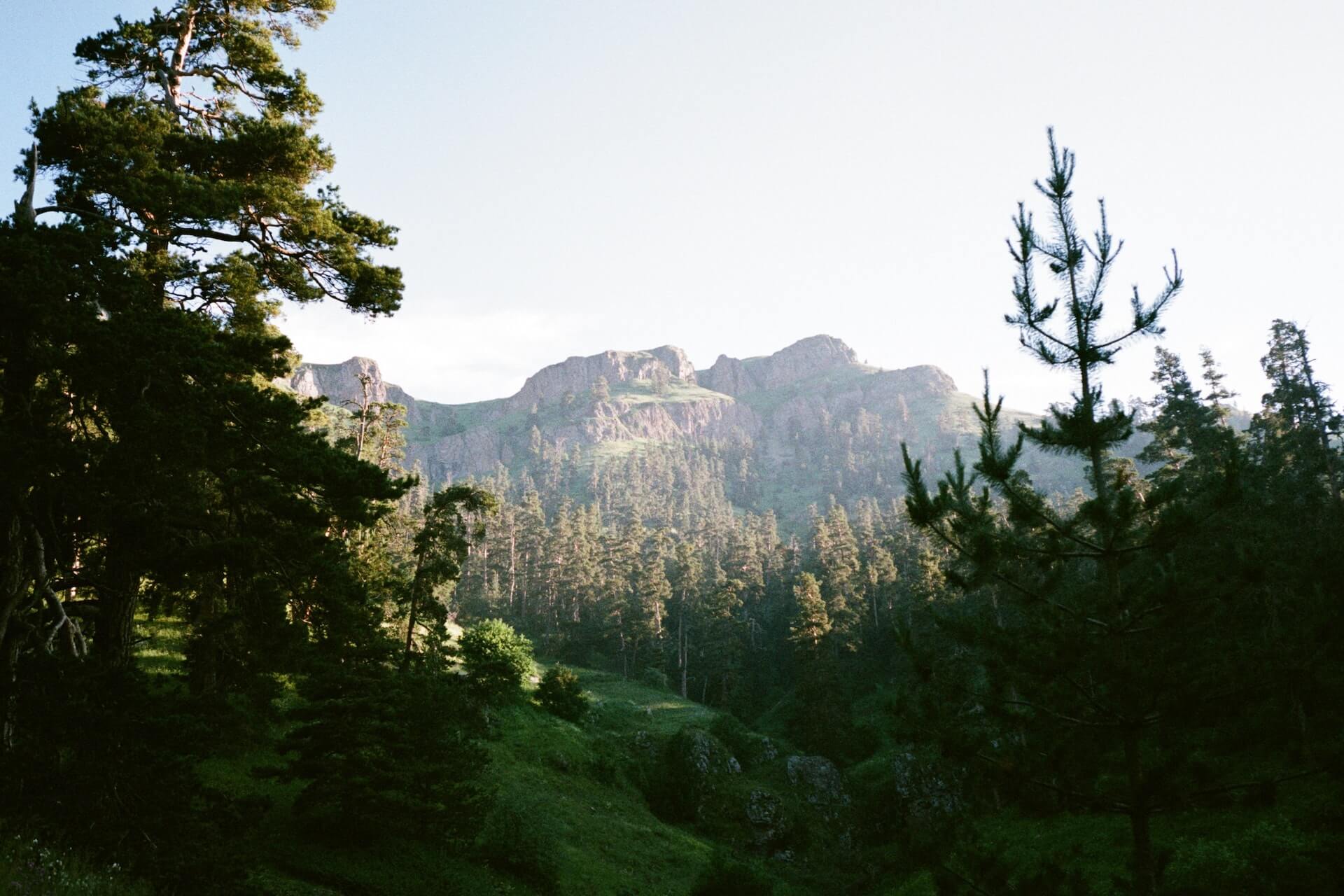
Further on the way to Gori, you can turn around the city of Borjomi, known in Russia to older people because of its mineral water of the same name. Bottled carbonated Borjomi water was sold not only in stores, but also in all Soviet pharmacies. Before reaching Gori for a few kilometers, follow the sign to the left and you will find yourself in a city famous for its mineral water springs.
Borjomi is a medical resort with a mild climate, the population of which is 14 thousand people. The first plant for the production of bottled mineral water “Borjomi” was launched in 1953. Water is used by doctors to treat various stomach diseases. The resort was repeatedly visited by the Romanov royal family. For their reception, a palace was built, in which Stalin later stayed.
In an hour and a half, you can explore the main sights of the city – the aforementioned royal palace, the city park and the cable car, along which, after climbing the mountain, you can admire a magnificent panorama of the city and the mountain surroundings.
Don’t miss the opportunity to explore Mirza Riza Khan’s House next to the park. This holiday home was built for the Iranian consul, after his death, who became a museum of architecture. The facade of the building is decorated with elaborate wooden carvings and fences made of figured cast iron.
Gori
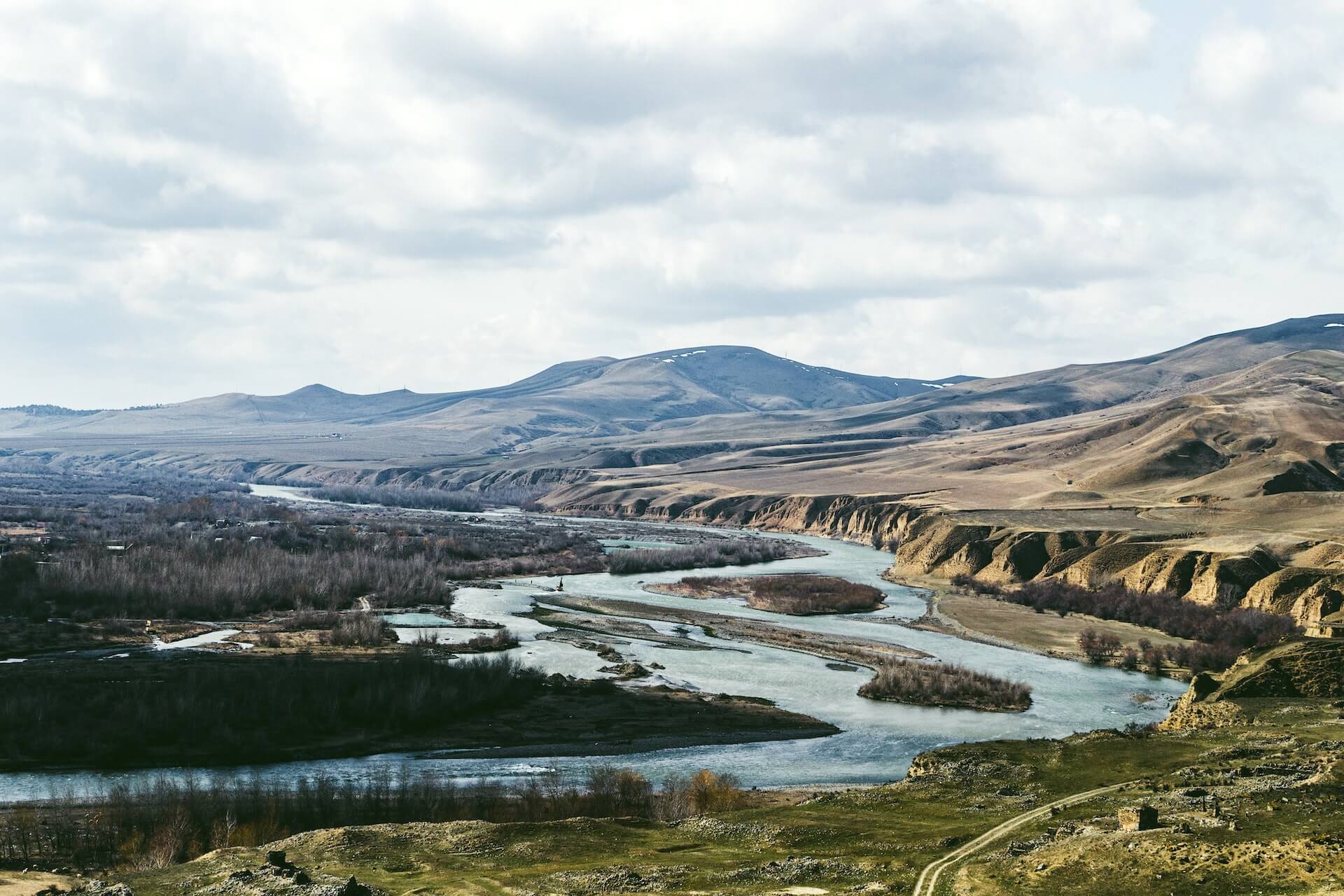
When you return home from Georgia, someone will definitely ask you about Gori, the birthplace of J. V. Stalin. Driving around almost the entire country and not visiting it will be a big omission. Therefore, the final point of the route Tbilisi-Mtskheta-Uplistsikhe-Borjomi on the way to Kutaisi will be this wonderful mountain city.
An ancient village in the picturesque Kartli valley at the confluence of the two rivers Kura and Bolshaya Liakhvi acquired the status of Gori city in 1801. The first mention of a settlement with this name is found in the chronicles of the 7th century BC.
Throughout its history, it has experienced many natural disasters and invasions of other peoples before the city finally became part of Georgia. However, already in the XXI century, the tragic events of the 2008 war took place here. Today, nothing reminds us of this here — it is a peaceful, clean and cozy city with a population of 54 thousand people.
Despite the various interesting sights of Gori, tourists tend to get to the House – Museum of Joseph Vissarionovich Stalin first (this is what the sign next to the door says). We must pay tribute to the citizens and political figures of Georgia, who during the years of debunking Stalin’s impersonality (when his sculptures were destroyed all over the USSR) they managed to preserve the monument to the leader of all nations and the museum itself.
In fact, the museum consists of three departments. The first is a poor old house in the oriental style of the XVIII-XIX centuries, where the future head of the USSR was born and spent his first 4 years of life. A neo-Gothic canopy with a colonnade has been erected over the house.
The second and main building is the main building – a grandiose palazzo in the Stalinist Gothic style with a beautiful tower, built in 1951. It contains the main exposition of the museum. There are many items that Stalin used, including furniture from his various workrooms. A big place is occupied by gifts from both leaders of different countries and from the peoples of the USSR.
The third interesting museum object is a railway saloon car, which, since 1941, was used by the leader of the Soviet country, including for trips to the Tehran and Yalta conferences. The car was presented to the museum by the North Caucasus Railway in 1985.
Prometheus Cave
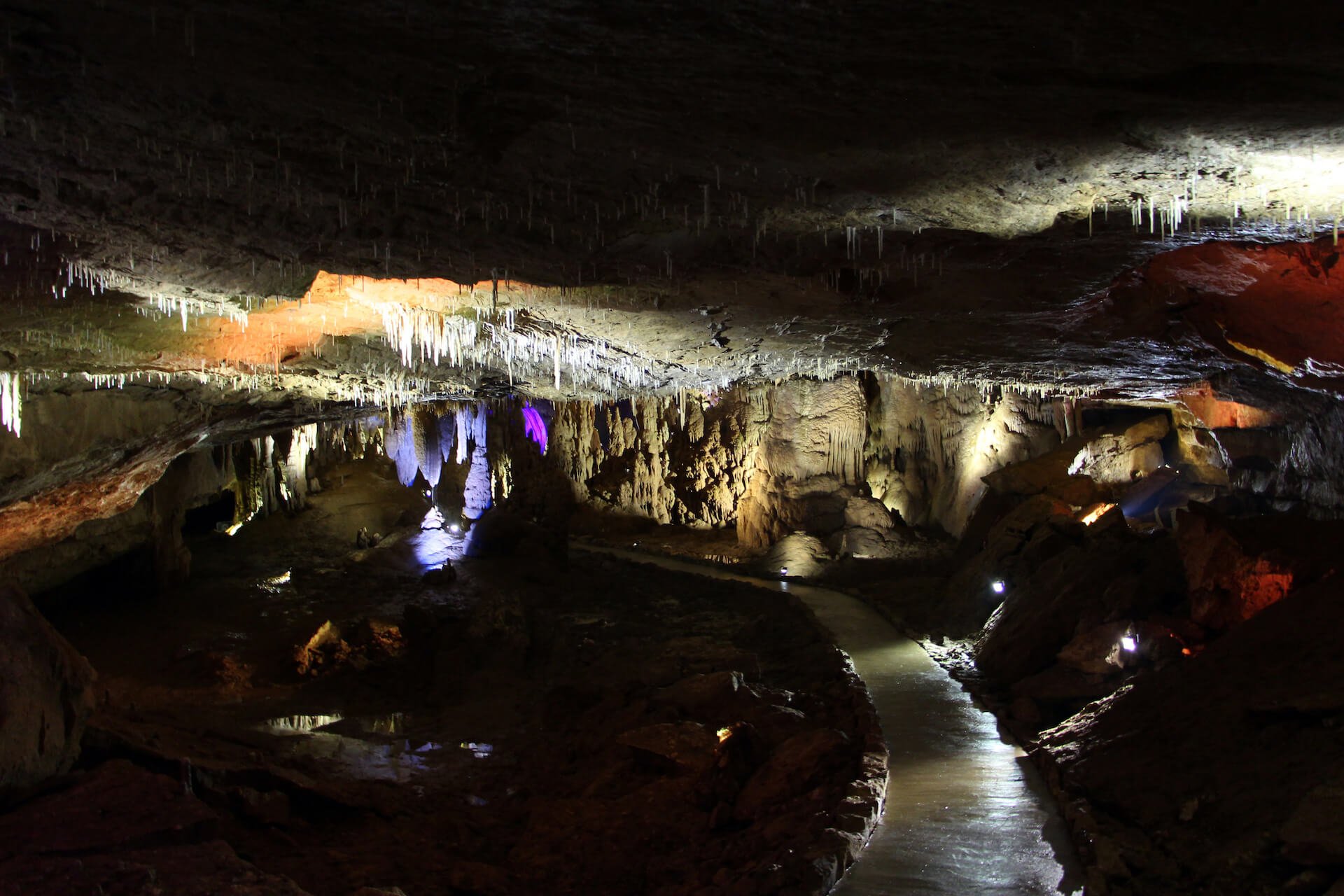
Near the town of Tskaltubo near Kutaisi is the Prometheus Cave. This name was awarded to the karst cavity in 2010 by the then President of Georgia Mikhail Saakashvili during his visit to these places. Kumistavi Cave, discovered by cavers in 1983, was renamed in honor of the hero of the Greek epic Prometheus. According to legend, the young man stole fire from the gods and gave it to people. For which he was chained to a rock in one of the caves of Colchis.
If you decide to move from Kutaisi to Batumi, then it’s time to visit the Prometheus Cave on the way. The expanded and equipped karst cavity with multi-colored lighting and wooden flooring is a grandiose fairy-tale spectacle. Entrance to the cave is paid.
You need to dress warmly as it is quite cool in the dungeon and the air temperature is kept at a constant mark of 14 degrees. The 1 km long cave route runs downhill from top to bottom. The tour lasts about an hour. Guests can enjoy a 30-minute boat ride on the underground lake.
Martvili Canyon
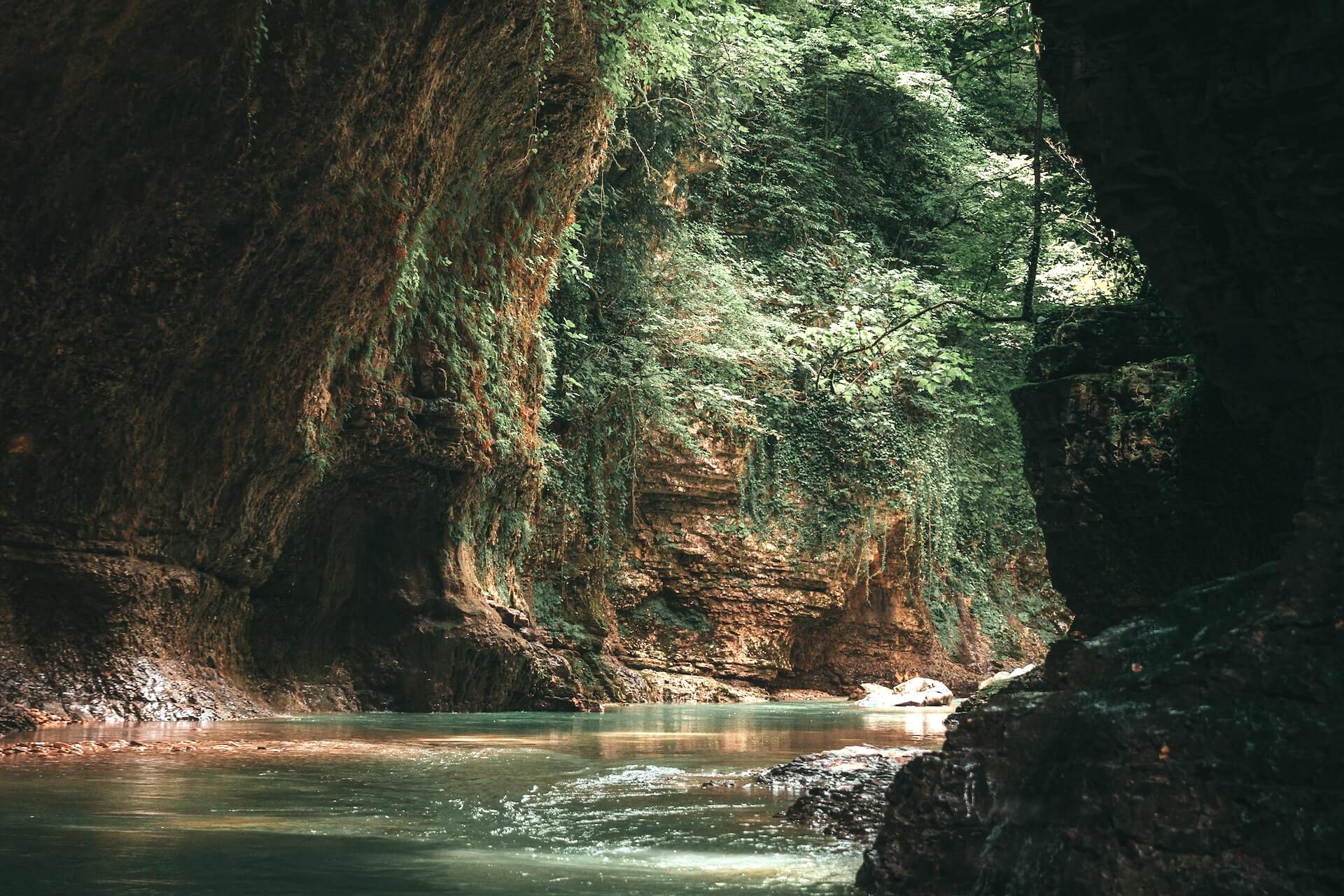
On the way from Kutaisi to Batumi, 55 kilometers away is Martvili Canyon near the city of the same name. This is a grandiose gorge, along the bottom of which the crystal clear waters of the turquoise Abasha River flow. The natural formation is divided into the upper and lower Martville canyons.
In the upper part, tourists ride inflatable boats 300 meters deep into the gorge. A 700-meter-long trail with viewing platforms is laid along the lower section. The canyons are open to the public all week from 10-00 to 18-00. Entrance is paid. The boat tour takes 1.5 hours.
Sighnaghi
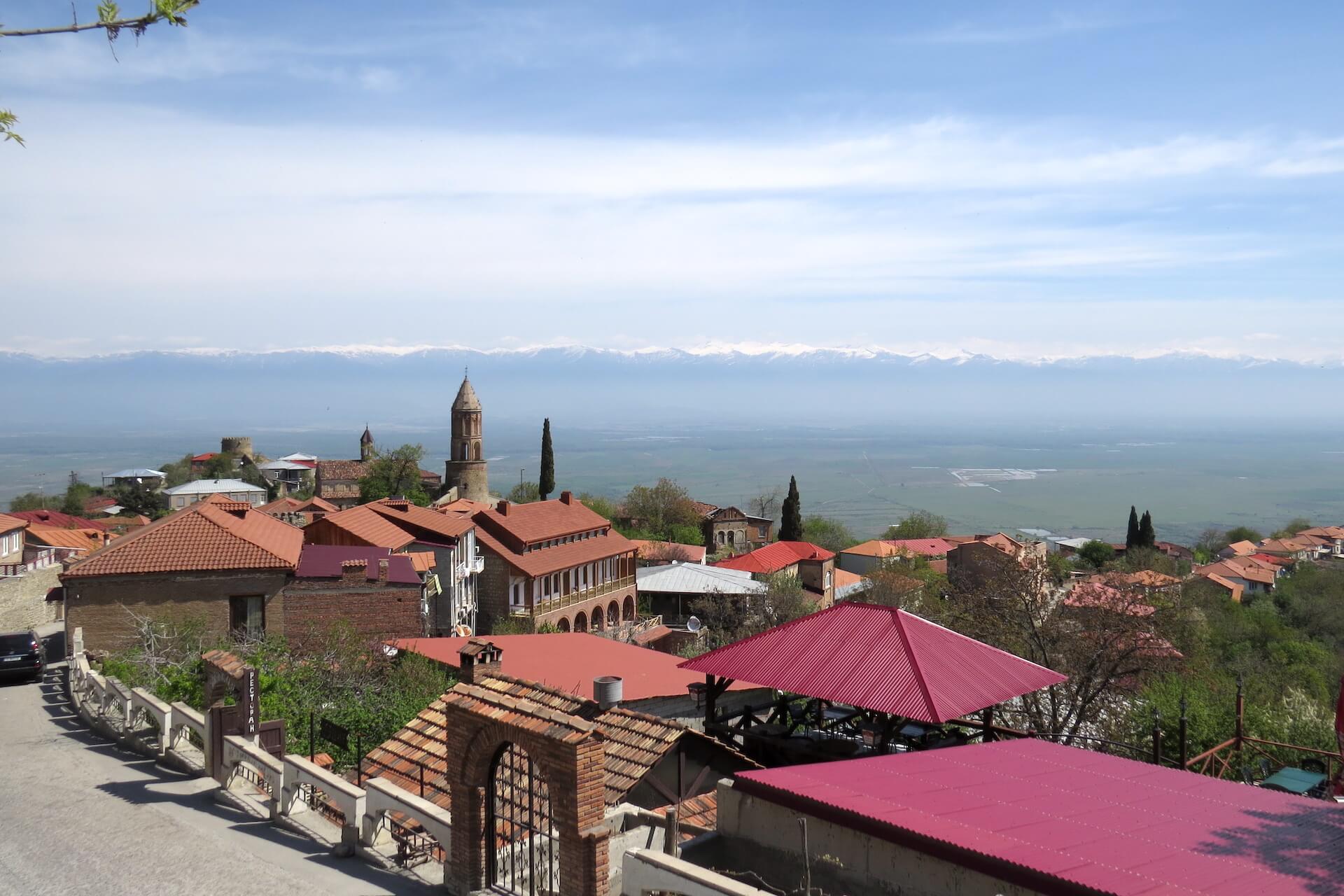
100 km from the capital to the east in Kakheti is one of the most romantic cities of Georgia – Sighnaghi, which attracts tourists with its beauty and well-groomed appearance. The silence and comfort of old cobblestone streets, small houses with red tile roofs create a fabulous atmosphere for couples in love.
Sighnaghi is informally called the city of love. He became famous for the fact that the registry office works here around the clock, where not only local residents, but also citizens of another country can sign at any time of the day or night.
The mountain village of Sighnaghi acquired city status by decree of King Heraclius II in the middle of the XVIII century. The modern town attracts thousands of tourists every year, who believe that a marriage made here will be happy for life.
Local attractions include the churches of St. George and St. Stephen, the Bodbe Monastery, the Local History Museum and the Pirosmani Museum nearby in Mirzaani village. The Sighnaghi Fortress occupies a central historical place. This is one of the largest ancient defensive structures in Georgia.
The fortress is almost completely preserved. The citadel is an irregular polygon in the plan. At the corners, battlements protect multi-story towers. In addition to the main gate, the fortress has several other passages. Entrance to the fortress is free.
Recently, city masters have become interested in street sculpture. On the streets of the city you can meet such figures as Benjamin on a donkey, a toastmaster, a Woman with a child in her arms and a Girl with a bouquet of flowers on a chair near the registry office. If you don’t have any problems over time, be sure to visit Sighnaghi.
Svetitskhoveli Cathedral
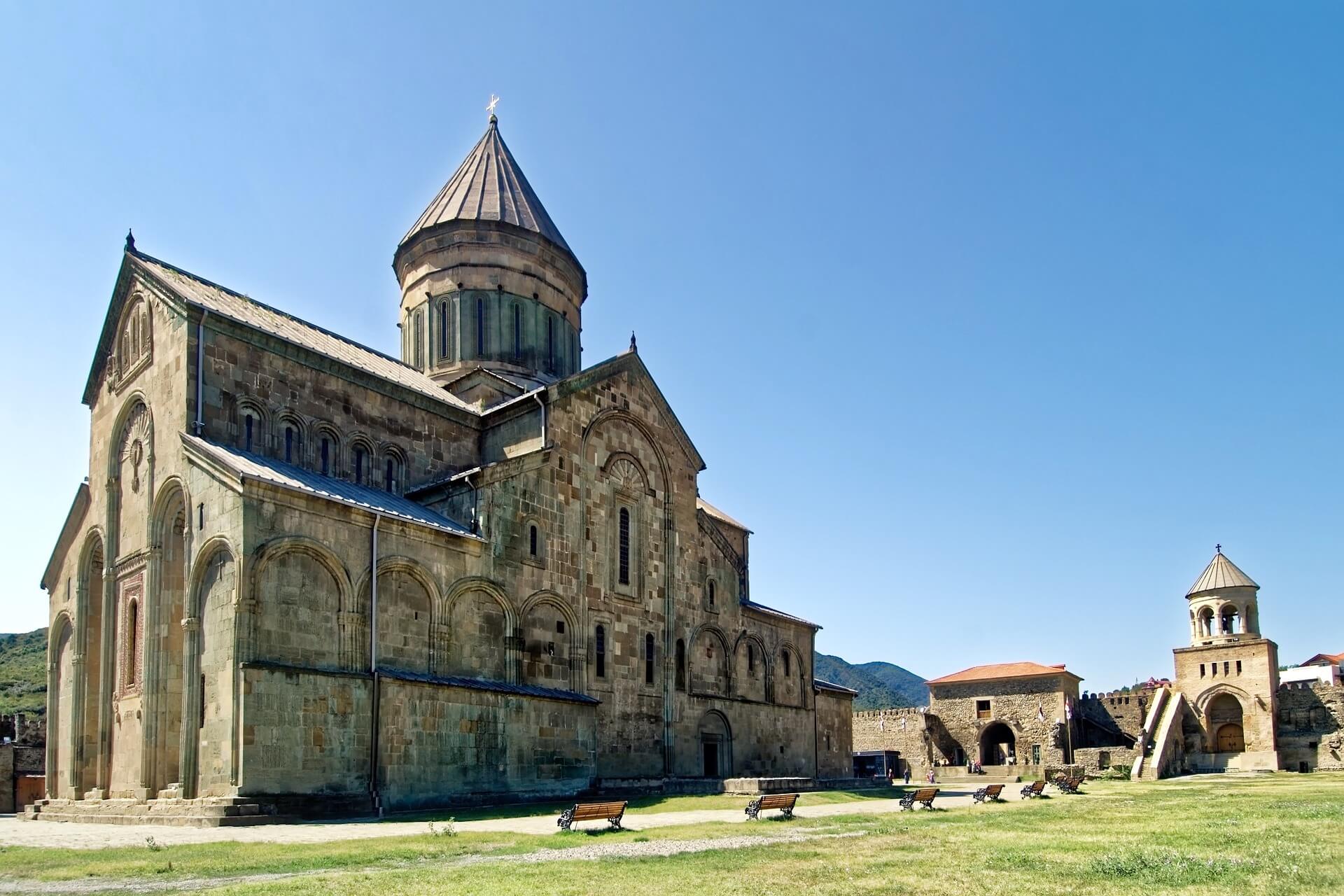
Built in the 9th century, the cathedral is today the largest surviving medieval church in Georgia. Within its walls there is a Christian relic-the Chiton of the Lord (the mantle of Christ). For a thousand years, the cathedral was the main temple of the state. There are many legends and stories associated with it.
The most popular of them says that at the end of the construction of the cathedral, the Georgian king ordered to cut off the right hand of the main architect, so that he could not repeat something similar in beauty. The cathedral contains the remains of many historical figures, including the legendary Georgian ruler Vakhtang Gorgasali.
Jvari
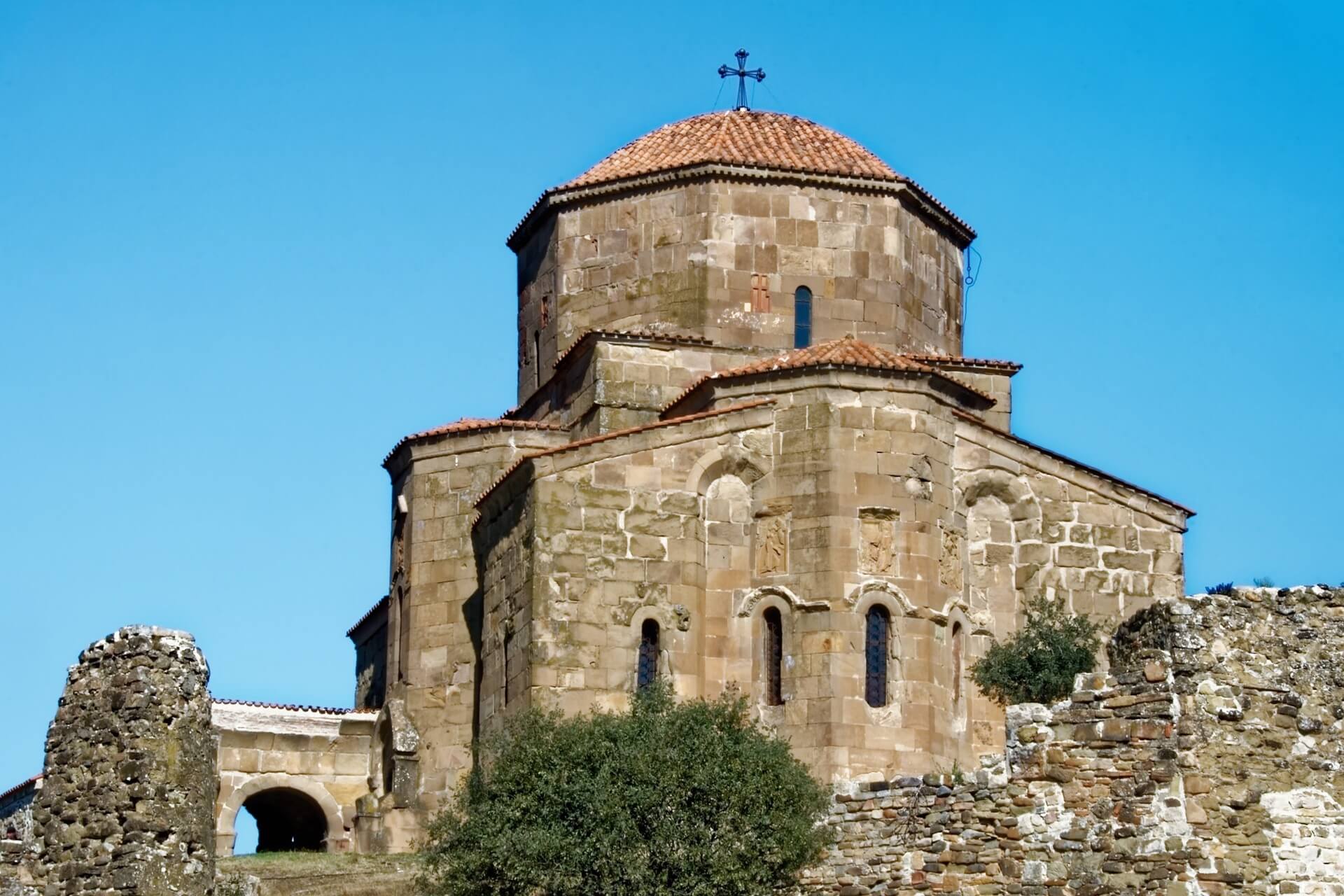
The sixth-century Jvari Orthodox Monastery is located near Mtskheta on the picturesque Armazi Mountain. The monastery gained wide fame because of its mention by Lermontov in the poem “Mtsyri”. The religious complex was built in 545 on the site where Saint Nina erected a wooden cross. In the Middle Ages, the monastery was surrounded by a fortress wall and put up a powerful gate, the remains of which have survived to this day. Entrance to the lavra is free, but the dress code is mandatory.
In addition, the remaining free time can be spent visiting the Samtavro Convent, where King Mirian III is buried, visiting the ruins of the ancient Bebristsikhe fortress of the IX century and visiting the medieval monastery of Shiomgvime.
Kvareli
Kvareli is located 150 km north-east of Mtskheta, as well as from Tbilisi in the Alazani Valley – a city of winemakers, surrounded on all sides by mountains. A small town with a population of 9 thousand people attracts tourists to the lake of the same name, the famous Kndzmarauli winery and Gremi Castle.
Kvareli Lake. The coastal territory of a small freshwater reservoir is a luxury resort with English lawns and a 5-star hotel. The water in the lake is not very clean and therefore it is not recommended to swim in it. Meanwhile, on the beach there are wooden gazebos with benches and tables, where you can have a great time with friends and a glass of good wine.
Kndzmarauli Winery
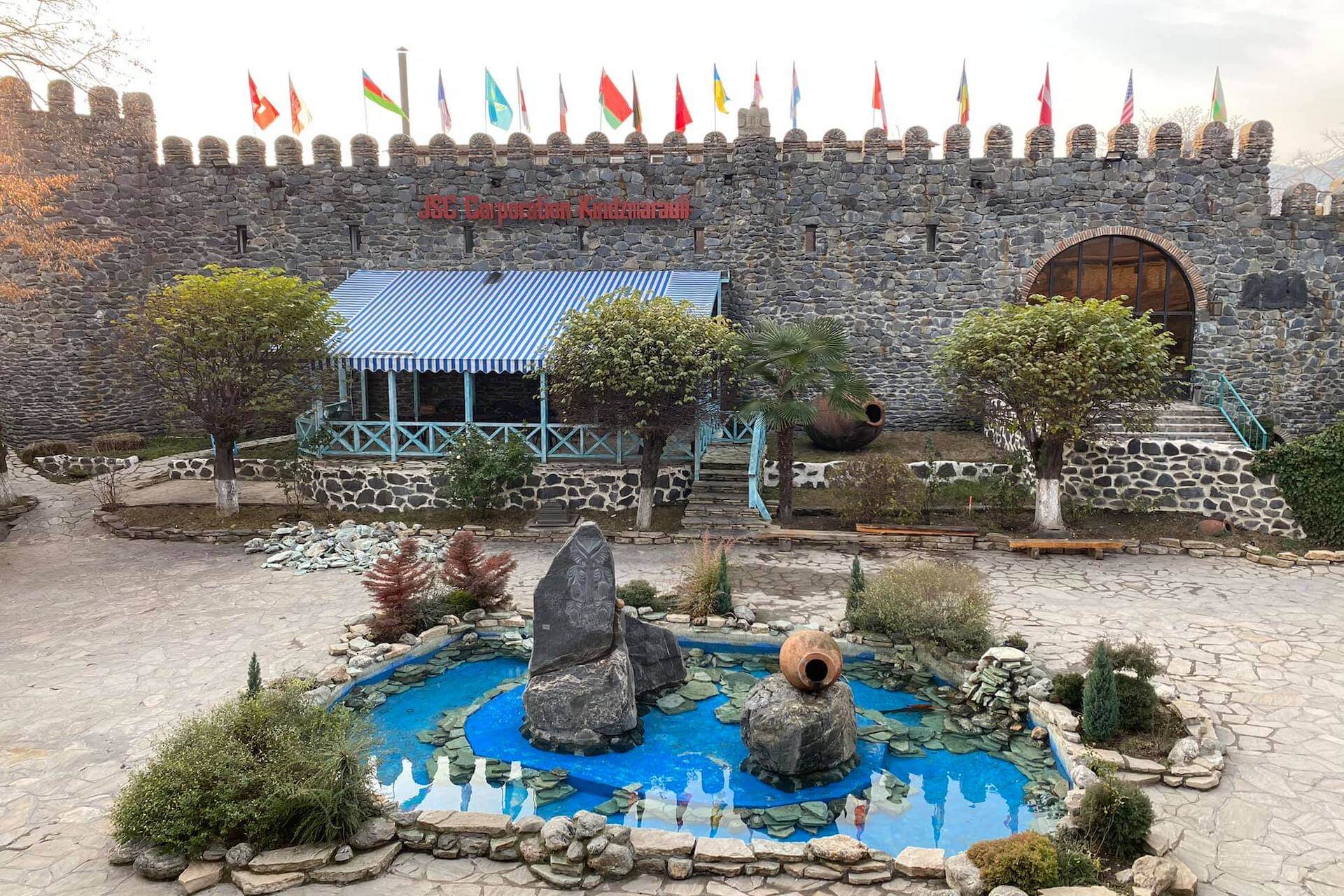
The winery, founded in Soviet times, is located in the center of Kvareli in Kakheti. Kndzmarauli Corporation is one of the largest and most famous wineries in Georgia. The first mention of mass production of wine dates back to 1533. Due to the large influx of tourists, two large halls were added to the old tasting room in 2015.
You can go directly to the tasting, paying for admission, or get there as part of a tour group after an informative walk around the factory. The tour will benefit from the fact that the guide will tell you about the secrets of winemaking and show you how the wine maturation process takes place. At the tasting, you will taste such wines as Kindzmarauli, Mukuzani, Kvareli, Kindzmarauli, Kisi, Twishi, 16×16, etc. Many of which can be purchased in bottled form at the factory store.
Gremi
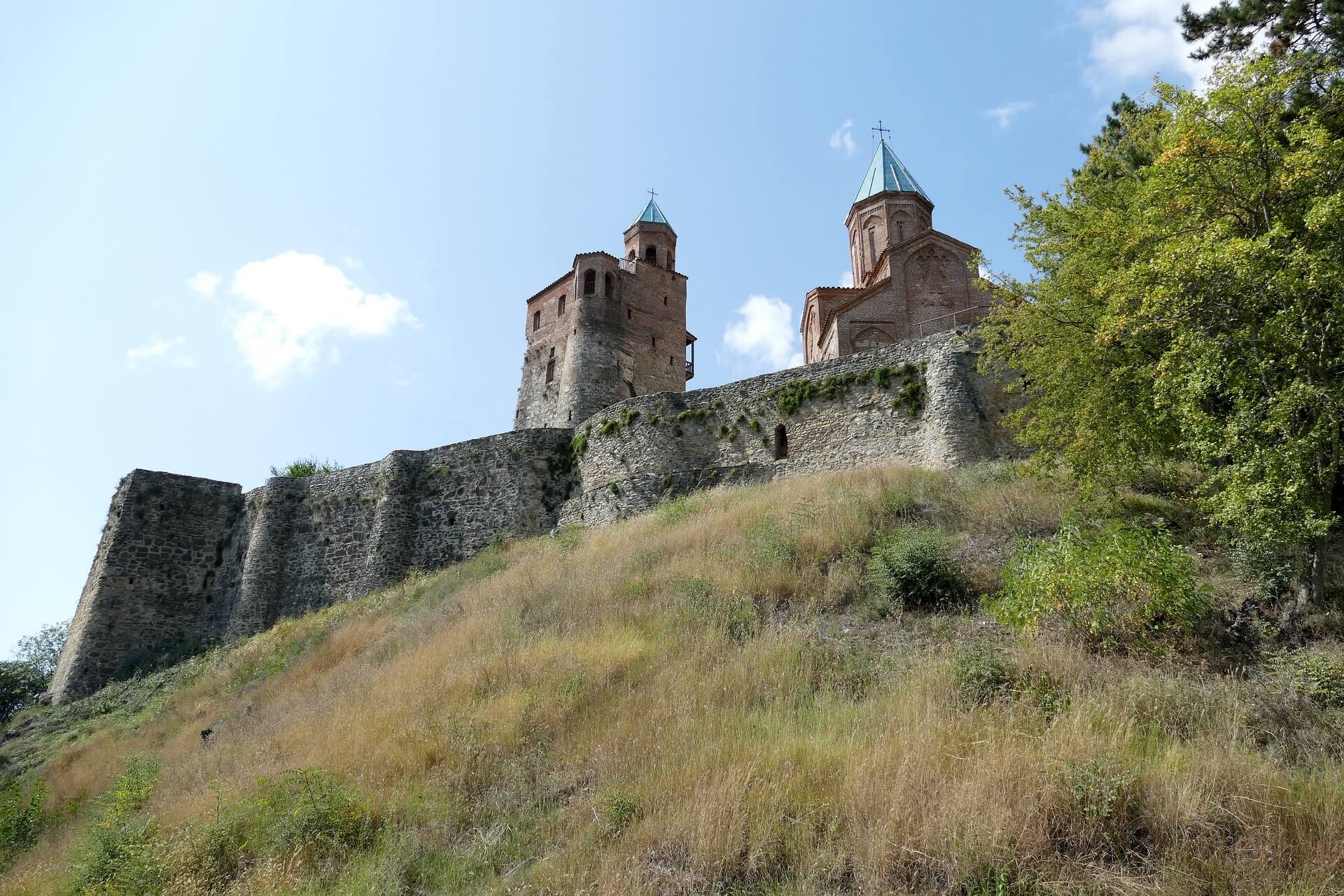
Not far from Kvareli there is an ancient historical monument – the Gremi fortress (castle). The citadel was built in the XVI century. The royal residence was located on its territory. The Church of the Archangels is the only one of all the structures near the castle that has survived to this day. The city of Gremi, destroyed by the Persian Shah Abass in 1615, was inhabited by Armenians. There was nothing left of it.
The castle and church are located on a hill. Around you can see the remains of fortress walls, towers and embrasures. There is also a three-story palace with a wine cellar. Amateur guides can show you the underground tunnel through which water rose to the fortress.
Next to the castle there is a parking lot and a souvenir shop. The fortress has a small museum, which contains ancient household items, weapons. All this was found nearby near the monastery of Nekresi.
Somewhere in the middle of the road between Tbilisi and Kutaisi, there are 4 interesting sites that you should visit to fully understand the diverse culture of the peoples of Georgia. These are the cities of Akhaltsikhe and Chiatura, the Vardzia monastery complex and the village of Khertvisi in Imereti.
Akhaltsikhe
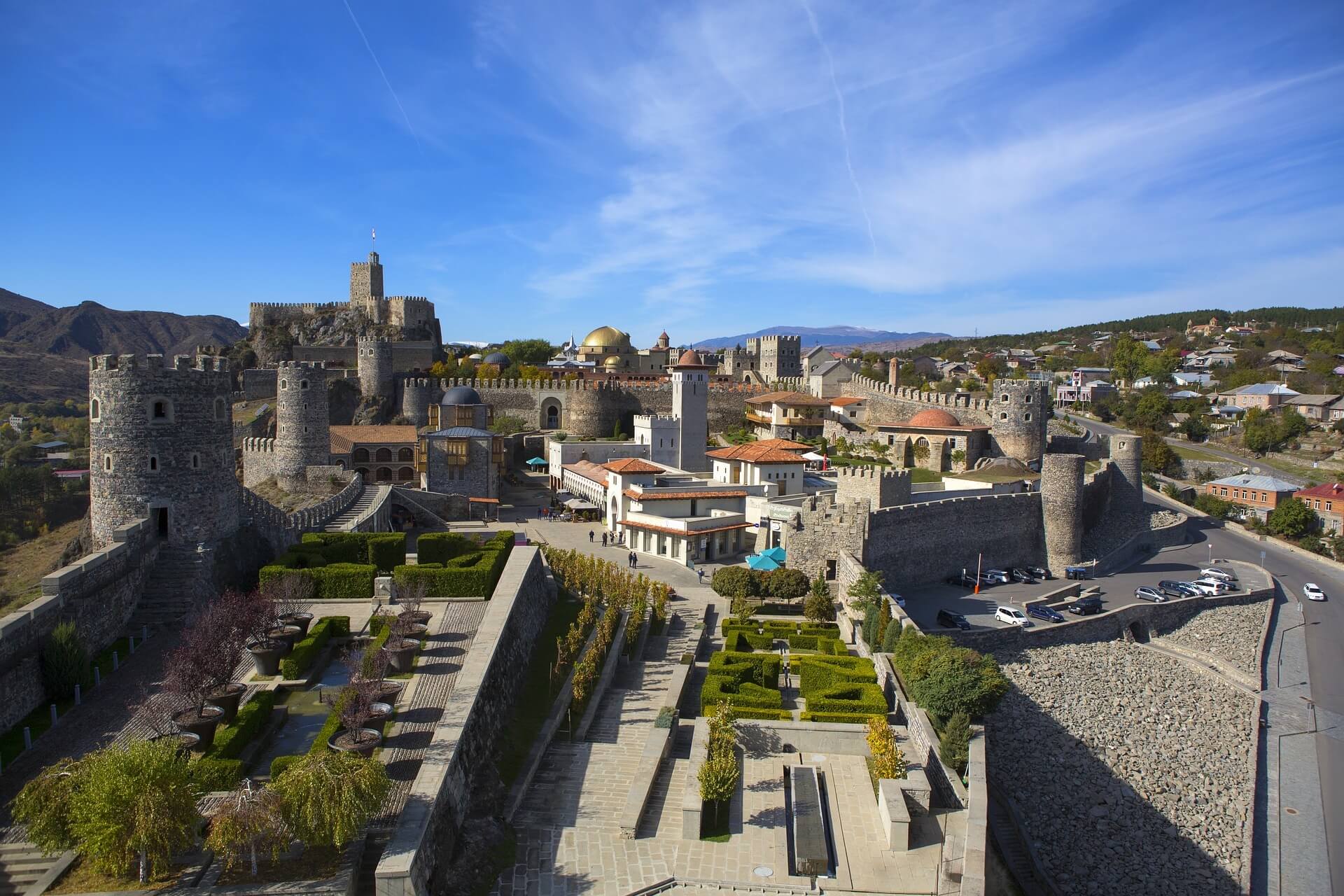
The regional center of the Samtskhe-Javakheti administrative formation, the city of Akhaltsikhe, does not have accurate historical information about itself. It is only known that in 1826 the city fortress was recaptured from the Turks by the Russian commander Paskevich.
In the old days, Tamerlane’s troops and the Turkmen army passed through here. And in 1578, these lands were captured by the Ottoman Empire. During the Soviet era, Akhaltsikhe was a closed military city. Attractions and natural beauty of the modern city attracts a large number of tourists. Since 2010, Akhaltsikhe has been recognized as a major tourist center of the country.
The city has many historical monuments and structures. These include the Rabat Fortress – an ancient medieval defensive structure built in the XVI century. On its territory there is a museum, the exposition of which is a collection of ancient Turkish and Russian weapons – these are mainly muskets, sabres and cannonballs. Also here you can see a unique collection of Colchian axes.
Stone ponds are very popular among tourists. The swimming pools are located at the very entrance to the mosque. Nearby you can see hanging gardens – these are suspended bowls filled with a variety of vegetation. On the territory of the ancient fortress, it will be interesting to see the Jakeli Castle.
Vardzia
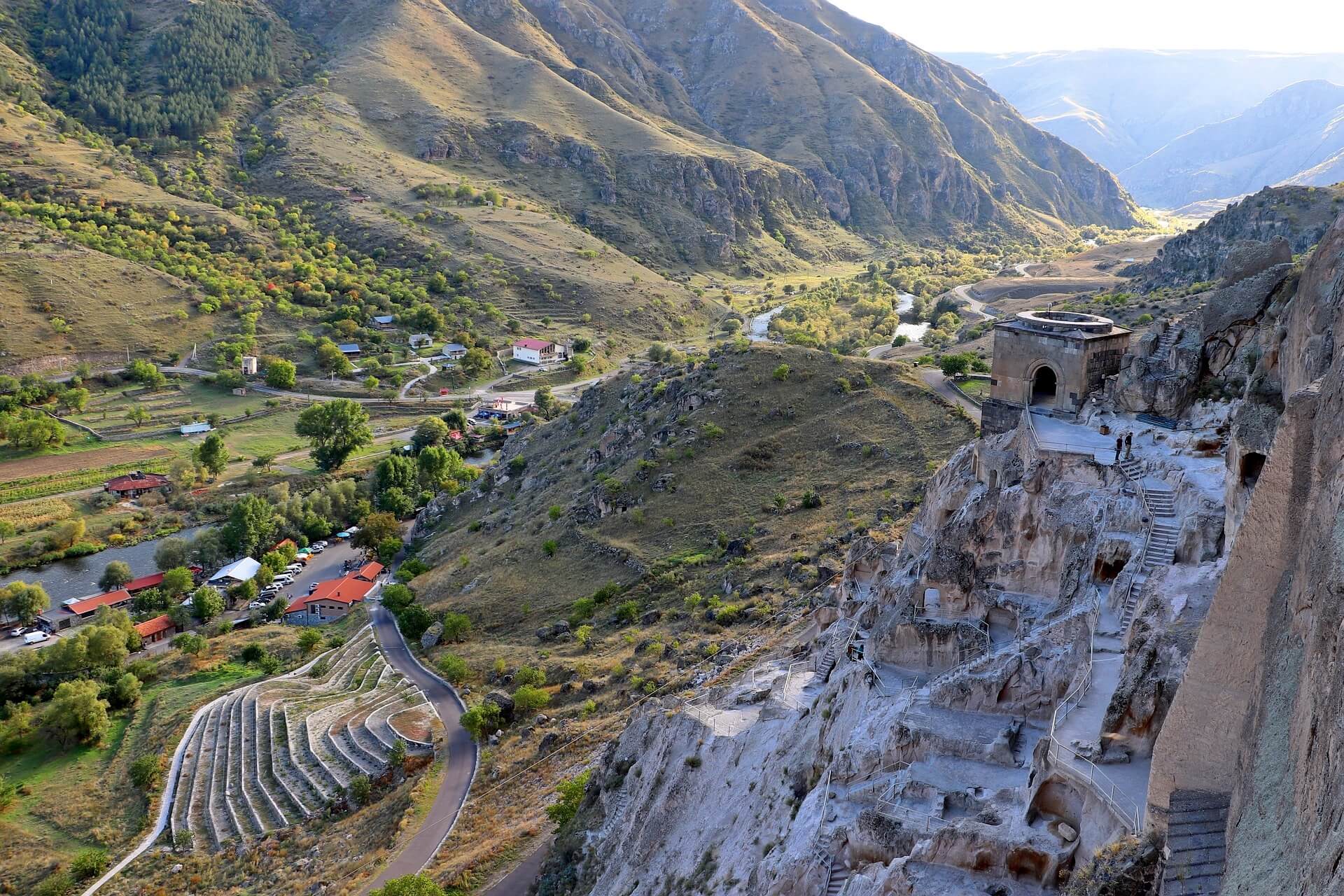
The monastery and cave town of Vardzia is located near the town of Akhaltsikhe near the village of the same name in the valley. Scientists attribute the time of the foundation of the cave monastery complex to the XII or XIII century. The attraction consists of 600 carved rooms in the steep tuff wall of Mount Erusheti for a kilometer above the left bank of the Kura River.
All the artificial caves go 50 meters deep and rise to a height of 8 floors. They housed churches and chapels, residential cells and storerooms, baths and refectories, treasury and libraries.
The central cave is occupied by the main Church of the Assumption of the Blessed Virgin Mary. From above, the hall-type temple is covered with a vault in the form of a box. To gain a deeper understanding of the grandiose vision of hardworking monks, we recommend exploring the monastery as part of a guided tour group led by a competent guide.
Khertvisi
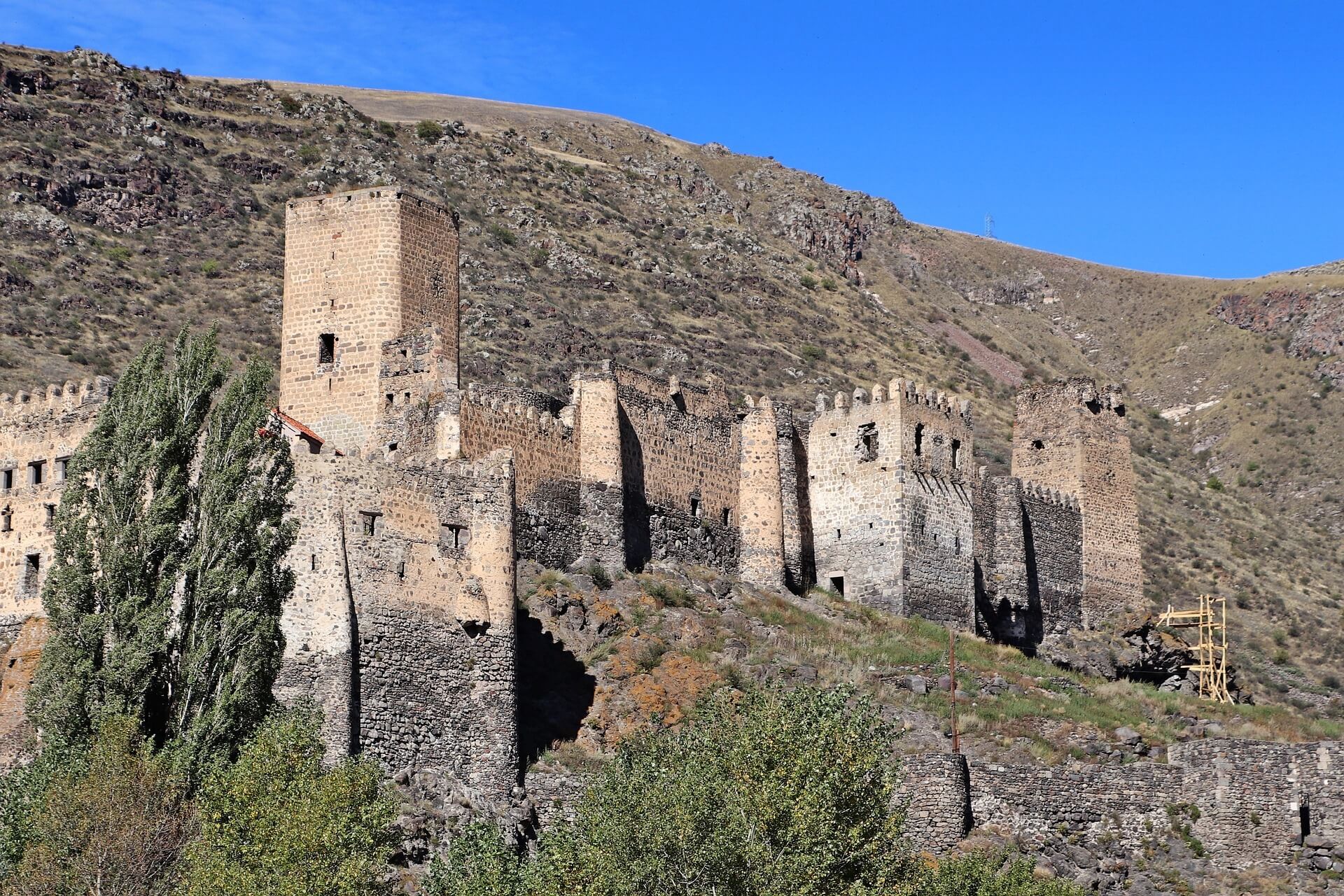
Very close to the Vardzia monastery cave complex is Khertvisi – one of the oldest fortresses in Georgia. There is no documentary information confirming the exact date of construction of the medieval castle. Scientists attribute this time to the X-XI century. Its purpose was to protect the road connecting the cities of Akhalkalaki and Akhaltsikhe, as well as control the banks of the Kura River. In 1283, the citadel was severely damaged due to an earthquake.
The castle is located on a high hill that divides the Kura riverbed into two branches. The fortress structure, thanks to the massiveness of the masonry, managed to carry itself through the centuries, almost completely preserved. The walls, loopholes and all the battlements retained their shape. The ancient city surrounding the fortress has not reached our days.
Since the castle is located by the road, it is very easy to drive up to it. Khertvisi is guarded around the clock. Access to the castle grounds is free. At the entrance, you can be met by local Cicerones who offer a guided tour for a small fee.
Chiatura
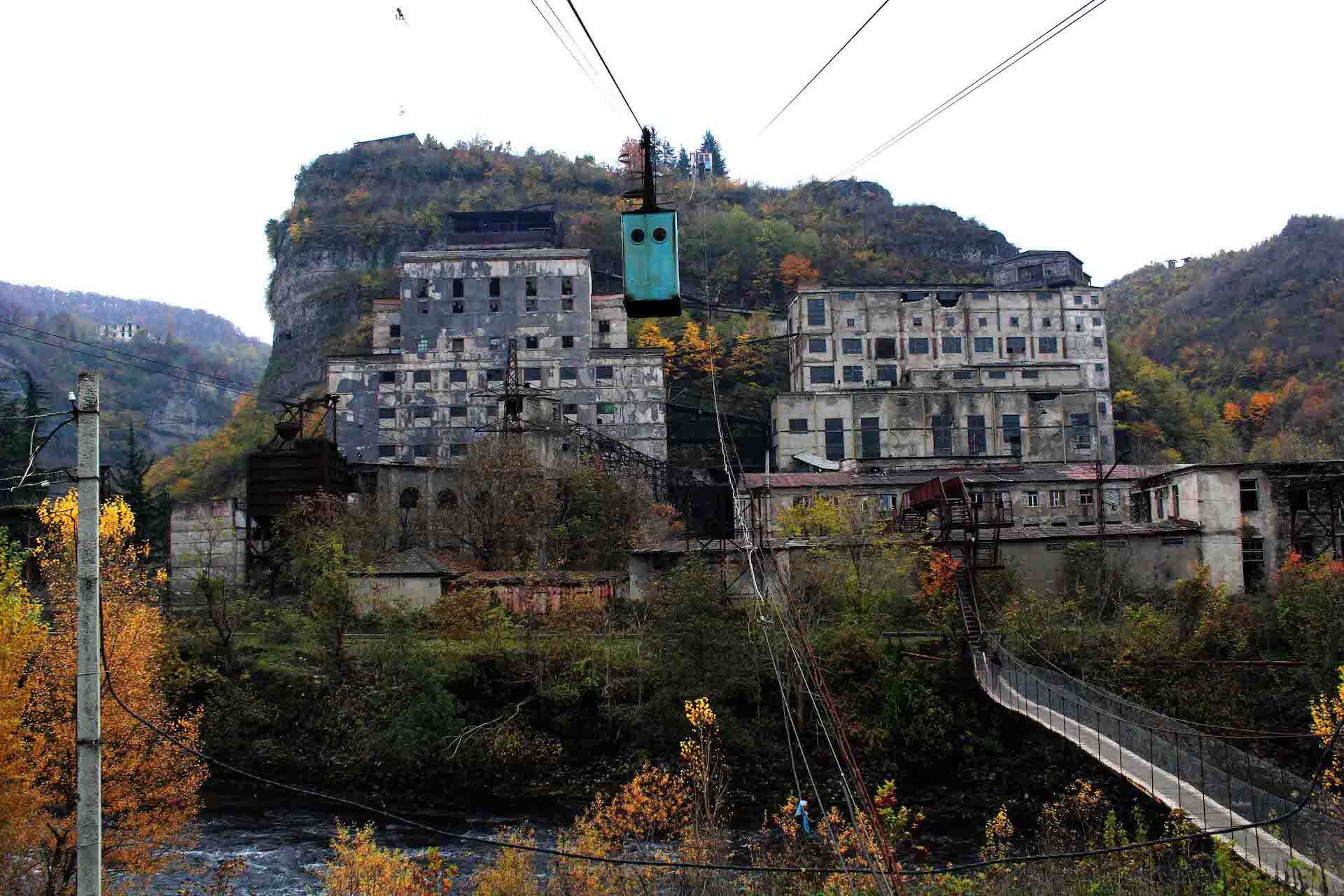
Chiatura is located in the gorge of the Rioni tributary of the Kvirila River and on the adjacent plateaus. Chiatura districts are connected to the central part of the city by cable cars. If you are invited to visit Chiatura, then know that you will not find anything joyful in the ghost town.
The active manganese mine is surrounded by dilapidated industrial and residential buildings left over from Soviet times. You can take a cable car ride over a depressing mining town and that’s all. It won’t be much fun. Although fans of the works of science fiction writers Strugatsky landscapes of the destroyed city will excite the imagination, comparing the environment with scenes from the “Picnic on the roadside”.
The next road trip will take us west to the Black Sea coast. You can visit Batumi – the capital of Adjara, Kobuleti and Poti.
Batumi
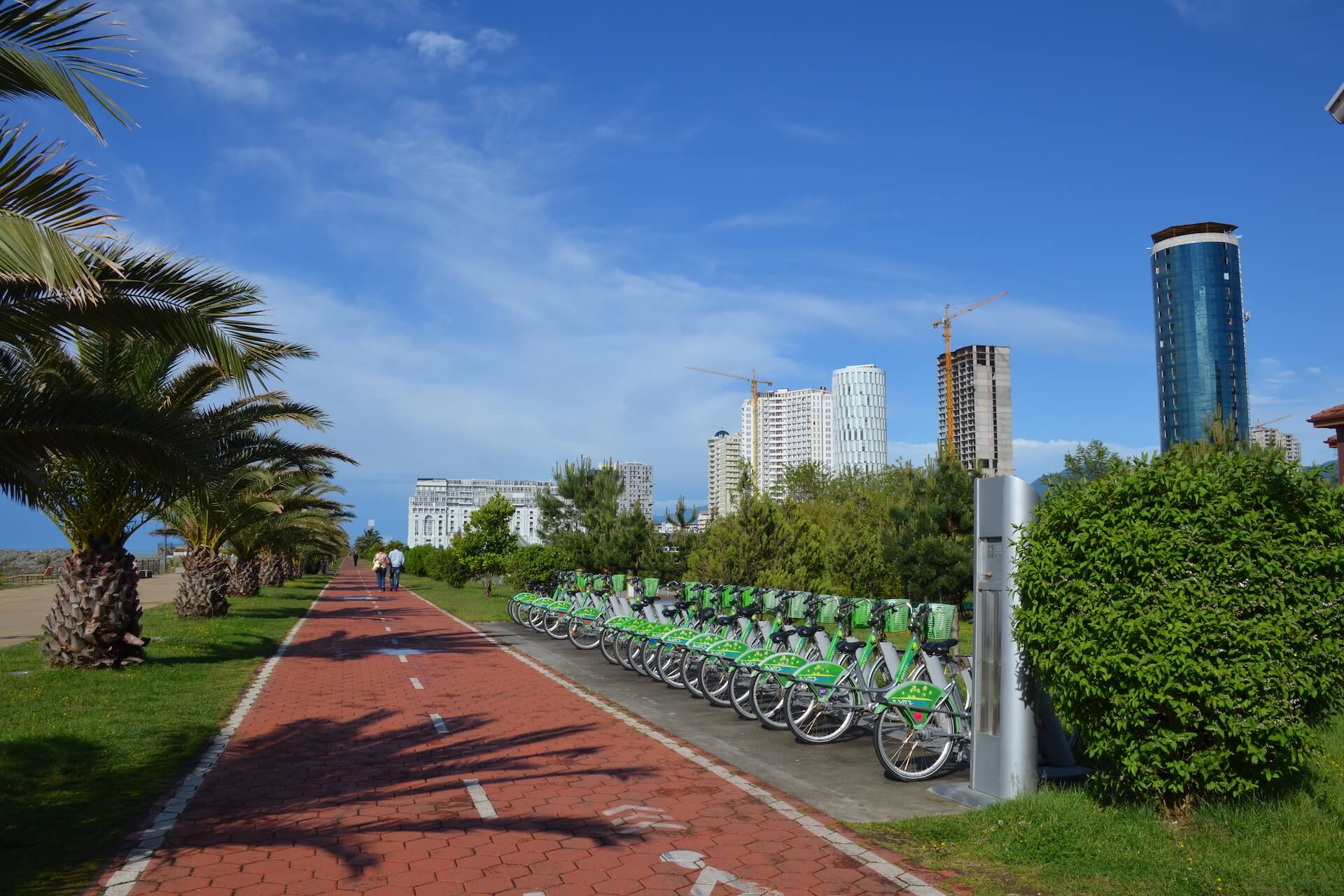
The capital of Adjara, Batumi, impresses the imagination with its modern architecture, designed in unusual forms of unsurpassed beauty, which can compete with the buildings and structures of Abu Dhabi in the United Arab Emirates. And Old Batumi fascinates with its atmosphere of the historical Batumi Boulevard, saturated with the smell of aromatic coffee coming from coffee shops against the background of old mansions on quiet streets.
In the evenings, the famous boardwalk is filled with thousands of tourists, eager for entertainment, which is full of both adults and children. Stretching for several kilometers, the well-maintained embankment is full of various shops, restaurants and cafes.
There is a Ferris wheel and children’s attractions. You will be pleasantly surprised by the abundance of street sculpture. Europa Square is decorated with beautiful buildings and a 130-meter-high sculpture called Medea with a golden fleece. In the capital of Adjara, you will find well-equipped beaches on the territory of sanatoriums and boarding houses, which have everything from changing rooms and showers, toilets, umbrellas and sun beds with beach towels, as well as tables with chairs. Without leaving the beach, you can have a delicious snack in the cafe.
Here, in a subtropical climate, the respiratory system, cardiovascular system, as well as nervous, skin and gynecological diseases are successfully treated. In Batumi, all conditions are created for a comfortable stay for both families and young people. At any time of the day or night of the summer season, guests of the city will not be left in a boring solitude.
Kobuleti
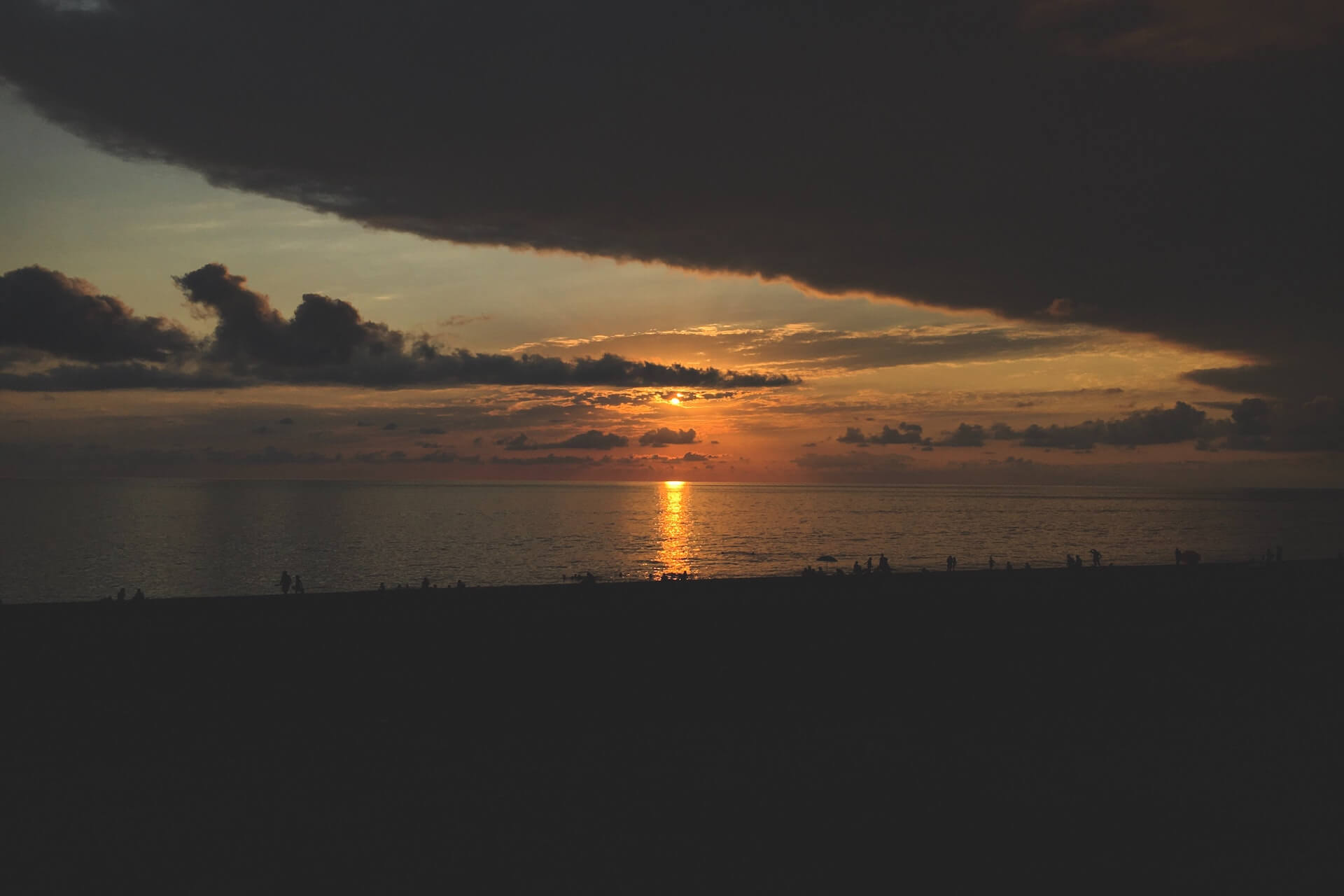
Kobuleti, the second largest city in Adjara, is located 20 km from Batumi to the north. This is a large youth resort, the beach strip of which lasts 10 kilometers. This is a great option to replace the crowded Batumi with a cheaper and less crowded resort with numerous guest houses, restaurants and a variety of entertainment options.
No wonder Kobuleti is called budget Batumi. If you stay in this city in the summer, you can spend some wonderful days relaxing on the Black Sea coast.
Poti

Driving north from Kobuleti, after 25 kilometers you will be greeted by the largest port on the entire Black Sea coast – the city of Poti. It is located at the mouth of the Rioni River. Every year thousands of tourists come here to rest. The history of the resort port dates back to the sixth century BC. According to the ancient geographer Strabo, a Greek settlement originally appeared here between the Rioni River and Lake Paliastomi.
Poti acquired the status of a city and its modern name in the middle of the XIX century, when it became part of the Russian Empire. From this moment, its rapid development and rapid growth begins. Poti, like Batumi and Kobuleti, is located in the subtropical zone.
Tourists come here not for a few attractions, but for inexpensive conditions for a beach holiday. We recommend visiting Lake Paliastomi, on the shore of which the Maltakva health resort is located. Here you can take advantage of and enjoy amazing SPA treatments at an affordable price.
Bakuriani

If your road trip takes place during the winter months, then it’s time to visit the Bakuriani Ski Resort. It is located in the middle of the road between Tbilisi and Kutaisi. Here, in the 30s of the last century, the first sports ski base in the Caucasus was established. Today, multi-million dollar investments have been poured into the resort, which has made it possible to create a modern infrastructure that meets high international standards. No one gets bored here.
It offers professional athletes snow-white tracks of extreme descent. For intermediate-level enthusiasts and beginners, there are gentle and safe descents. Children go downhill on snowboards, sleds and cheesecakes. Trails and descents are equipped with comfortable lifts. Thrill seekers are taken by helicopter to the top of Sakvelo Mountain and accompanied by an instructor on downhill skiing.
Georgia is a blessed country, rewarded with rich natural resources, populated by beautiful peoples, where guests from Russia are hospitably and hospitably welcomed, despite the temporary differences of politicians. Traveling by car allows you to get to know the country much better than from the window of a sightseeing bus.

